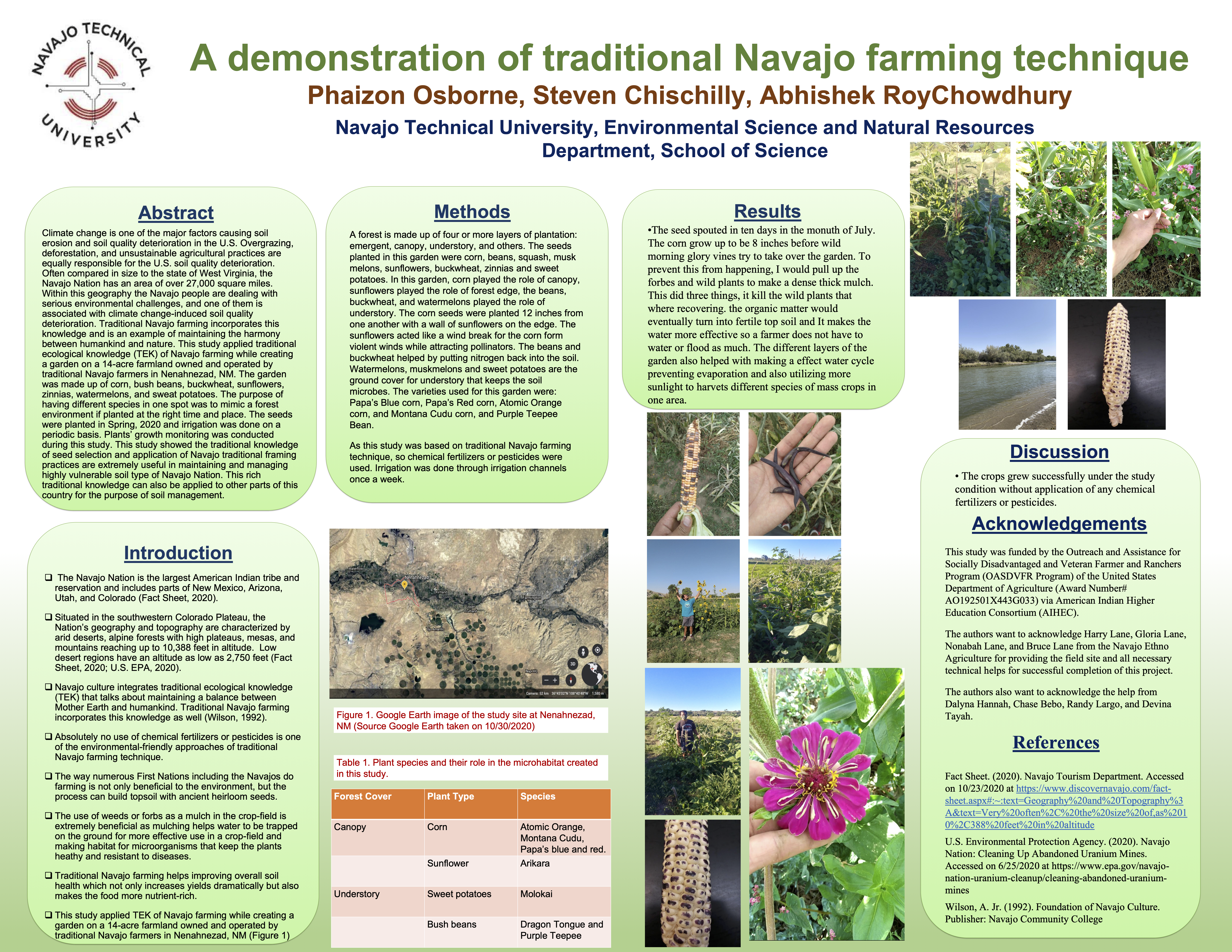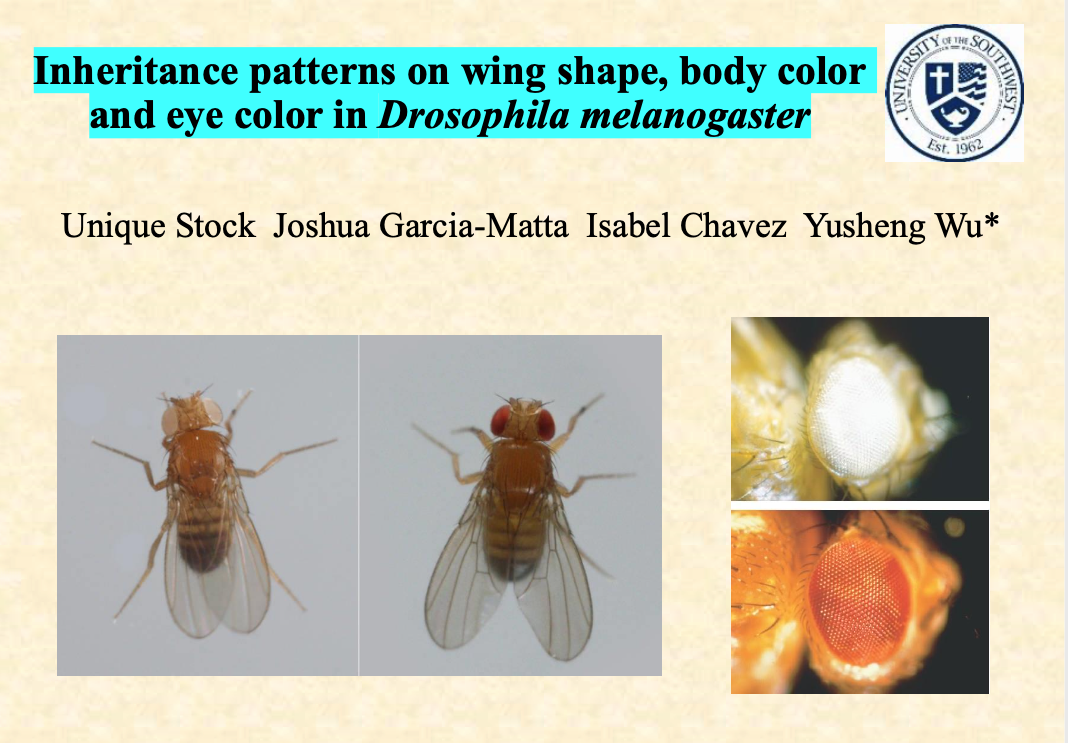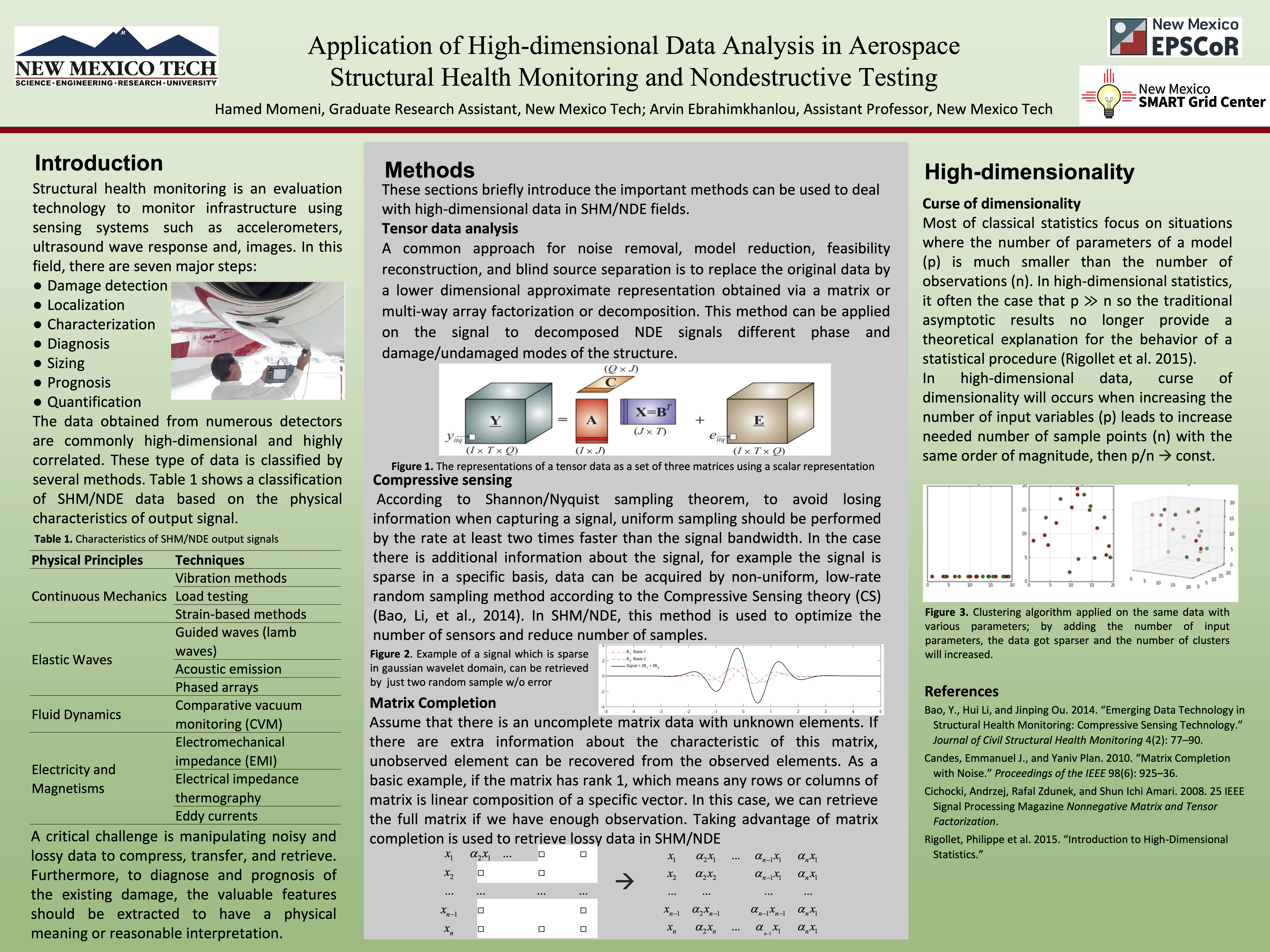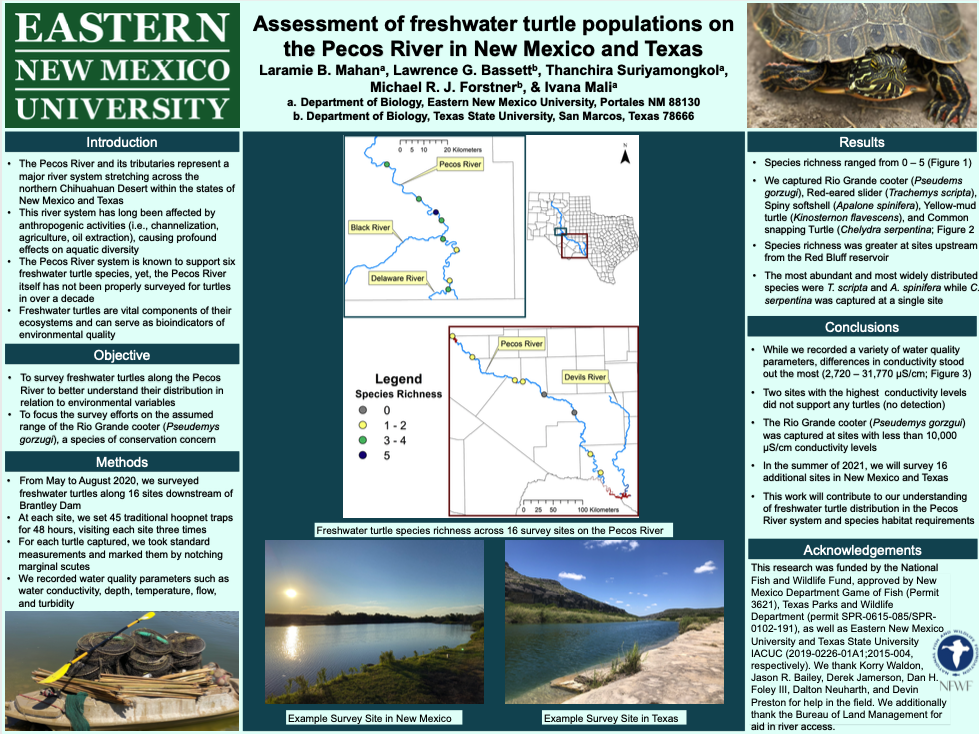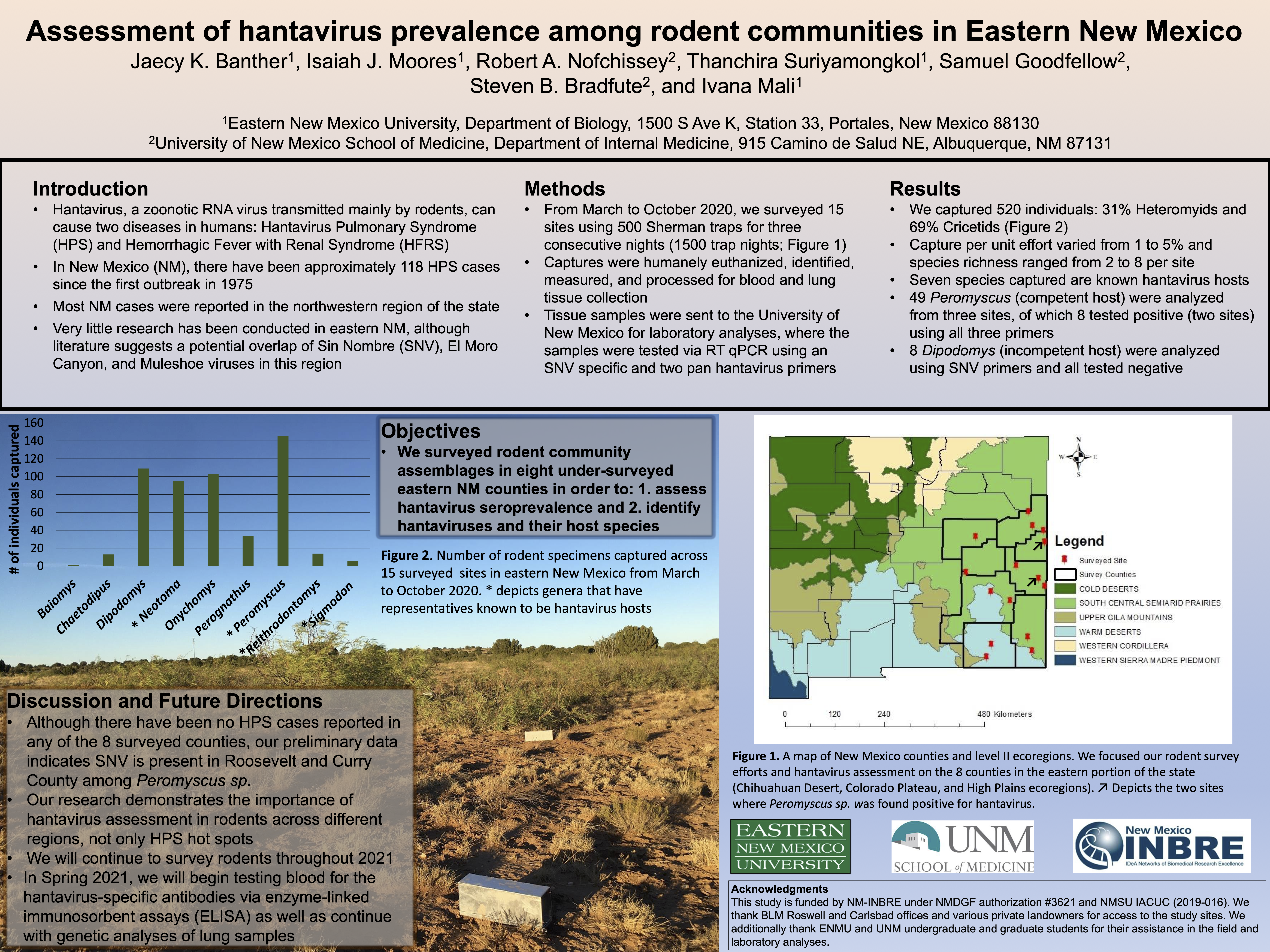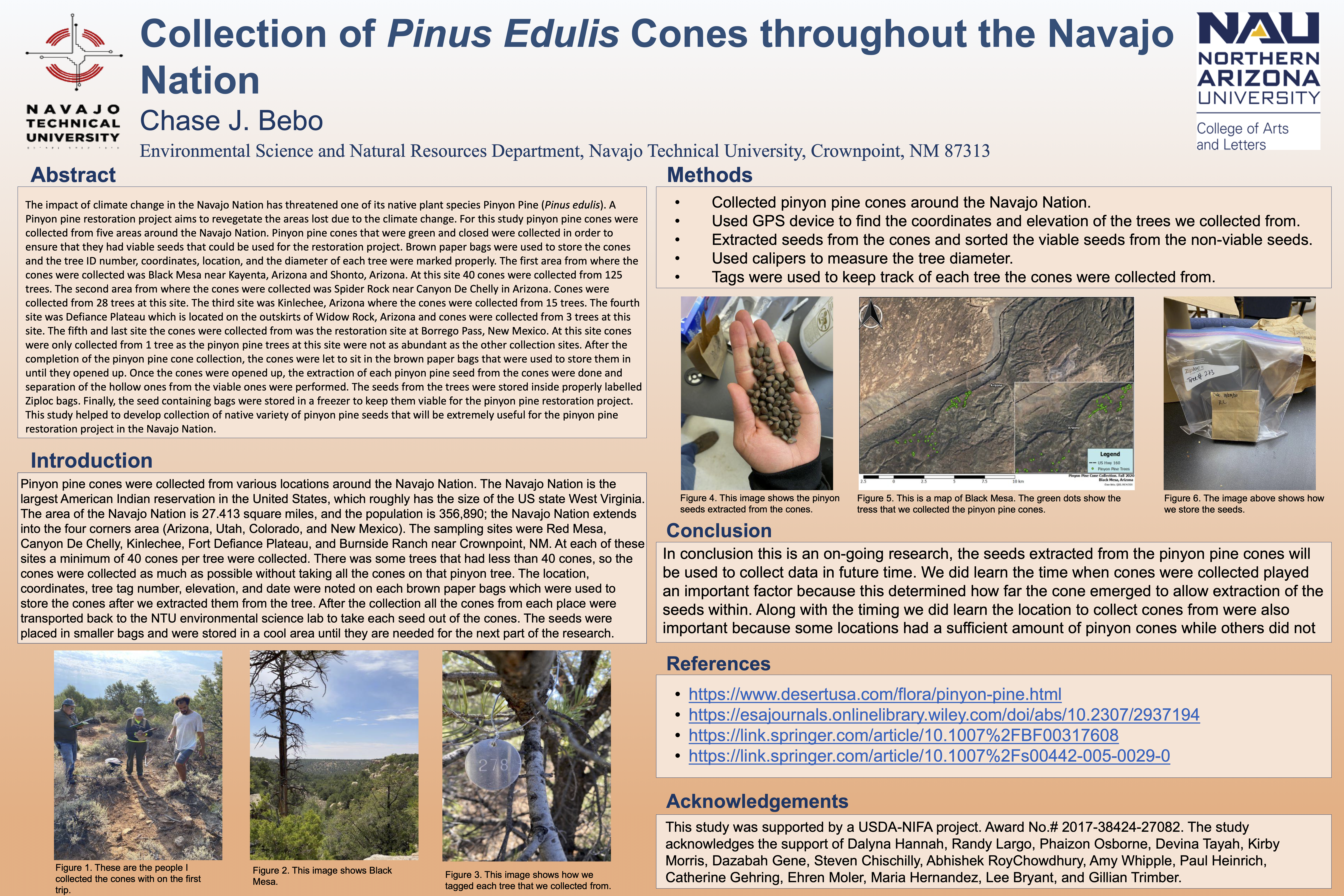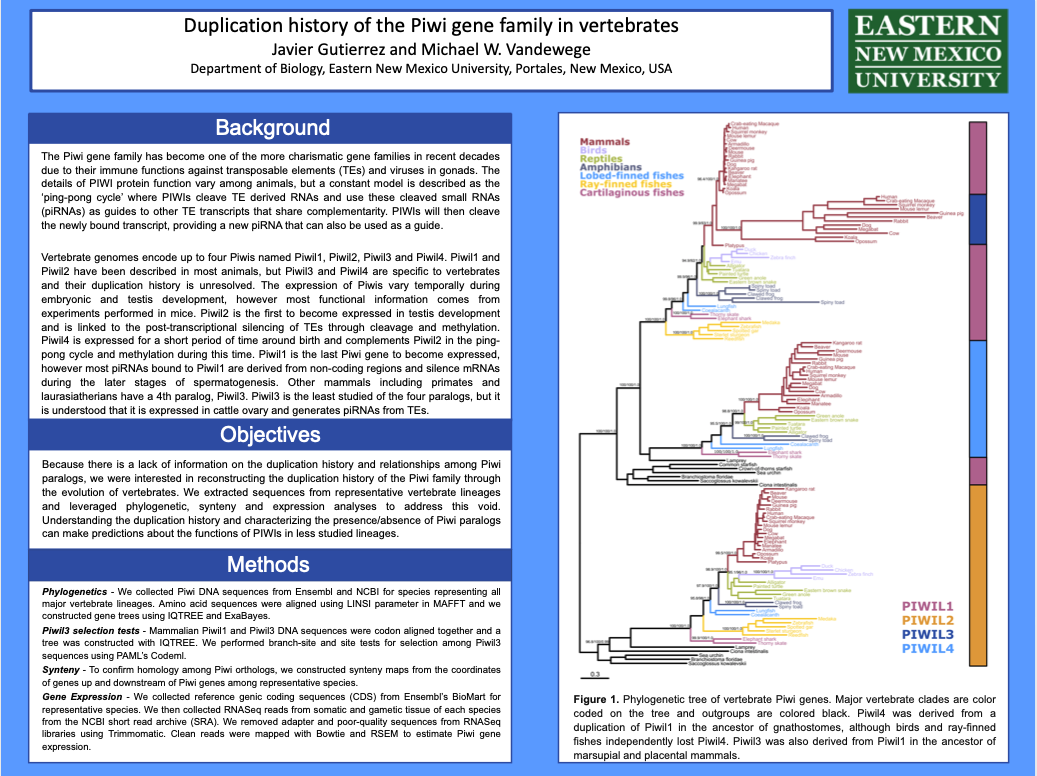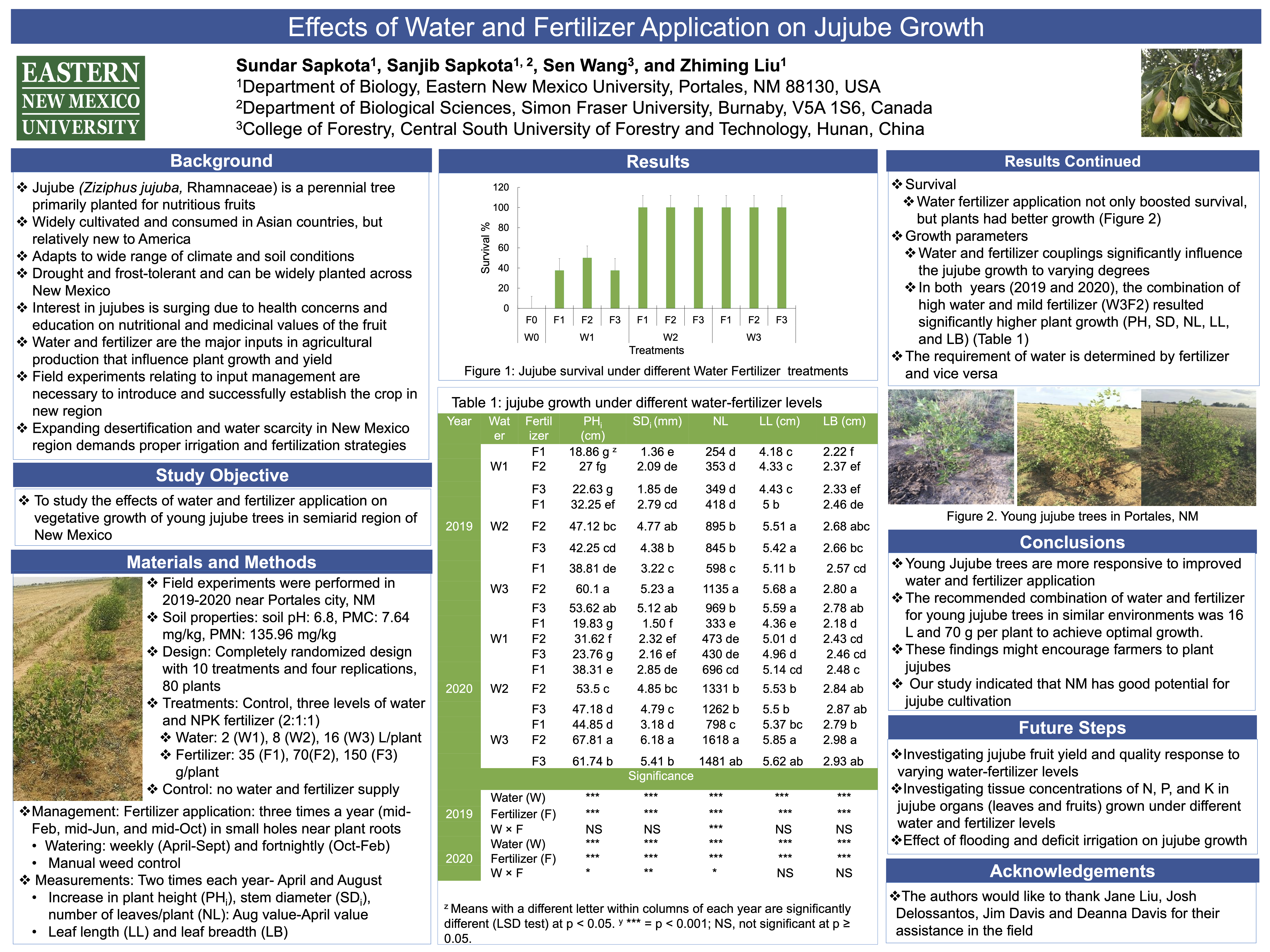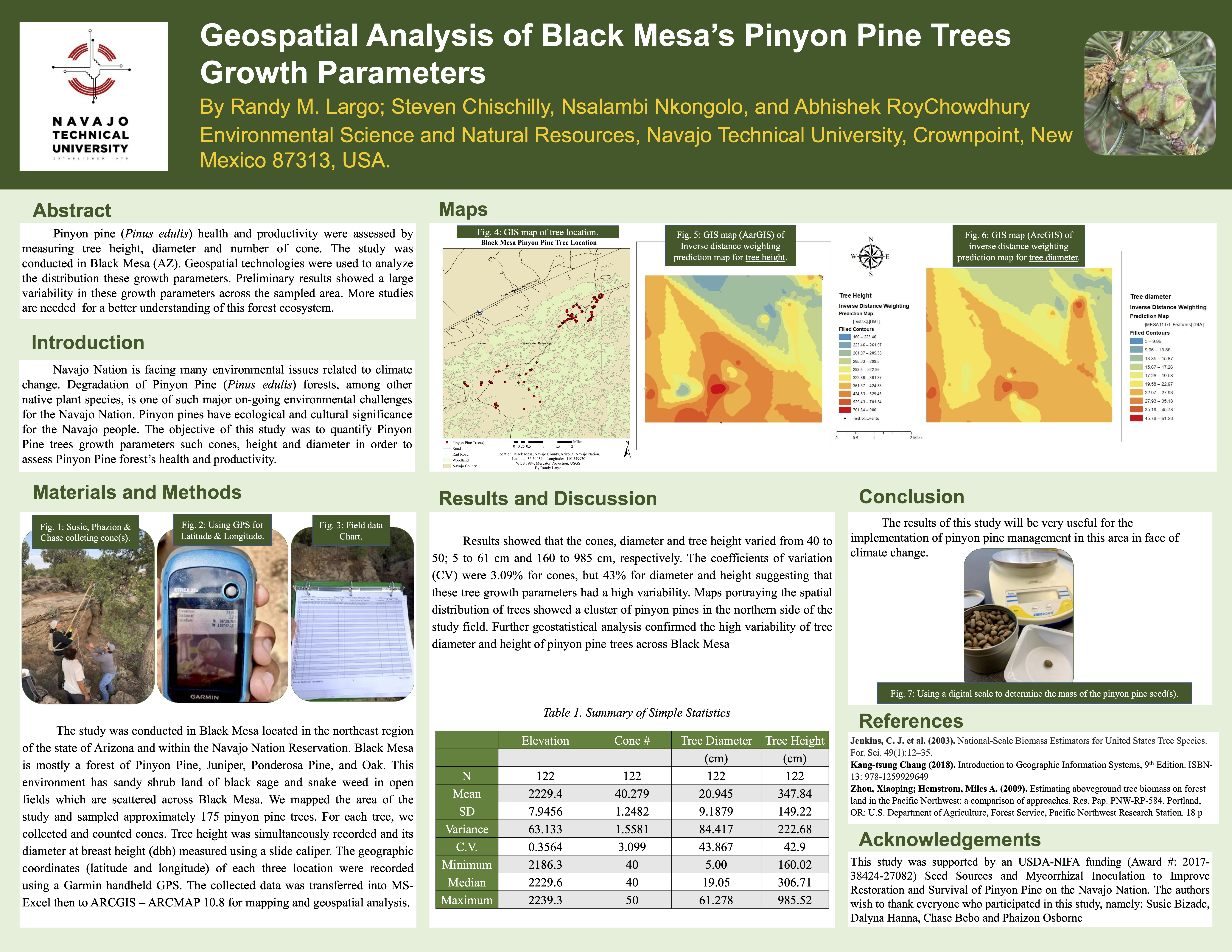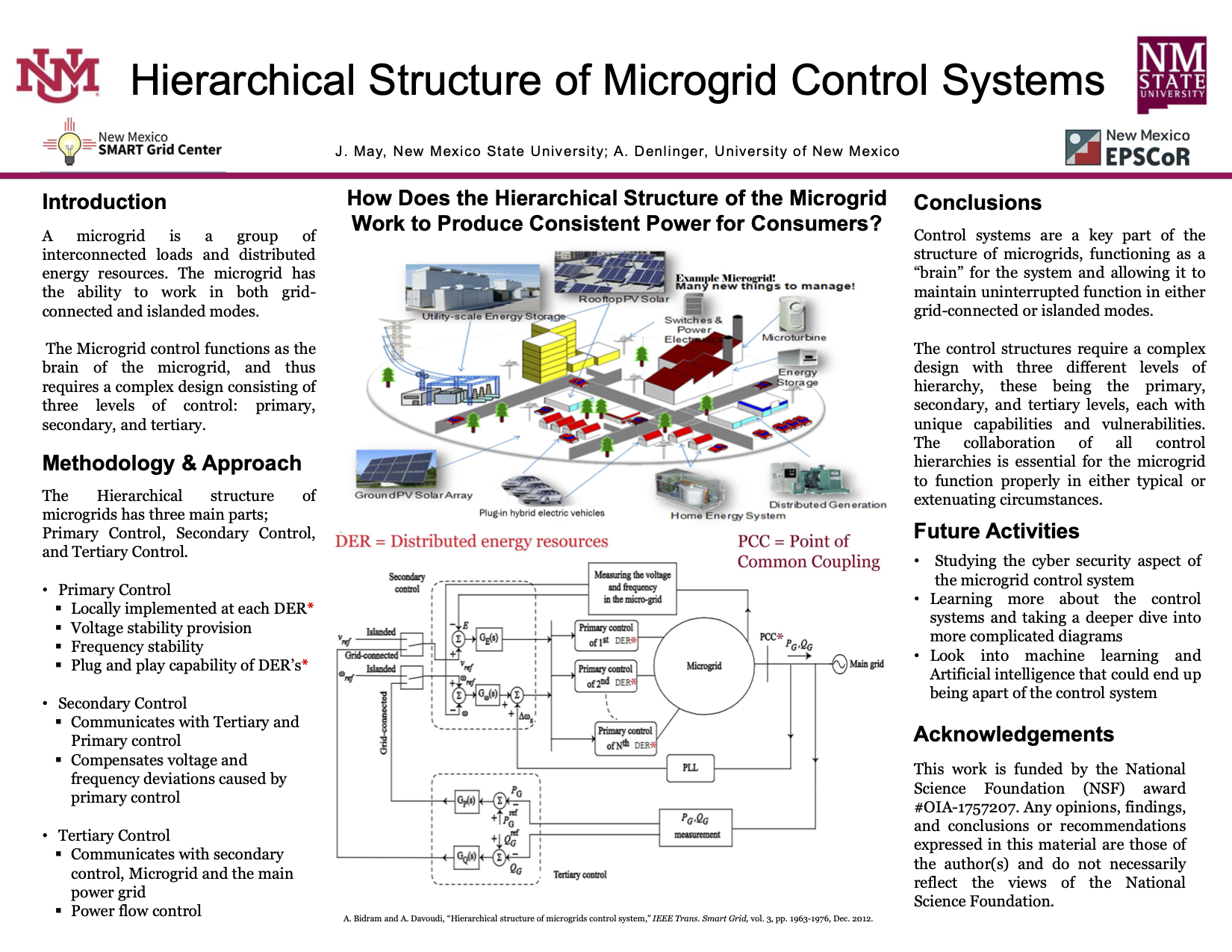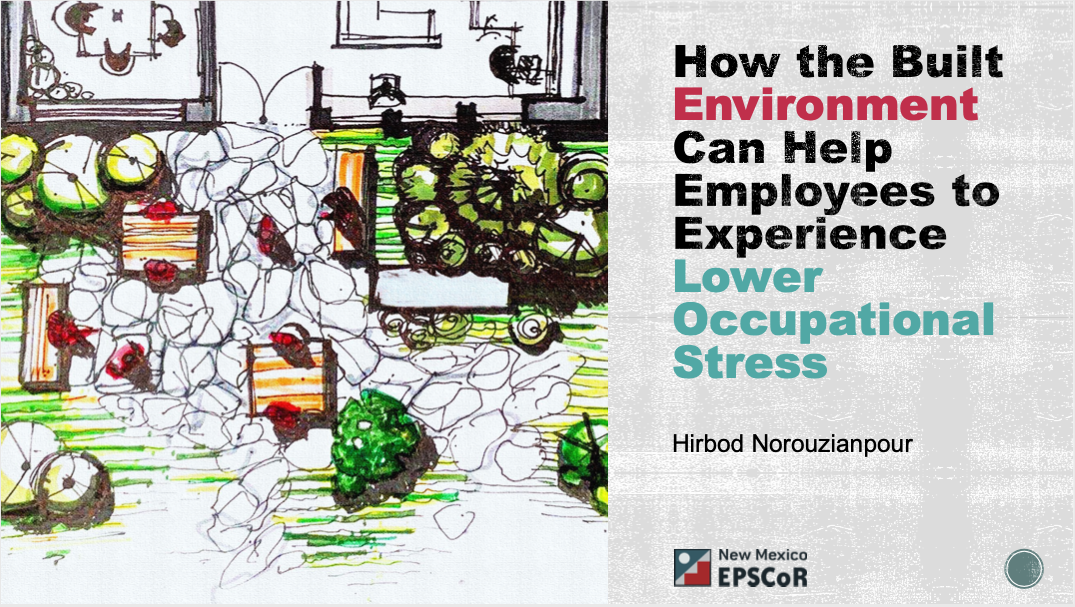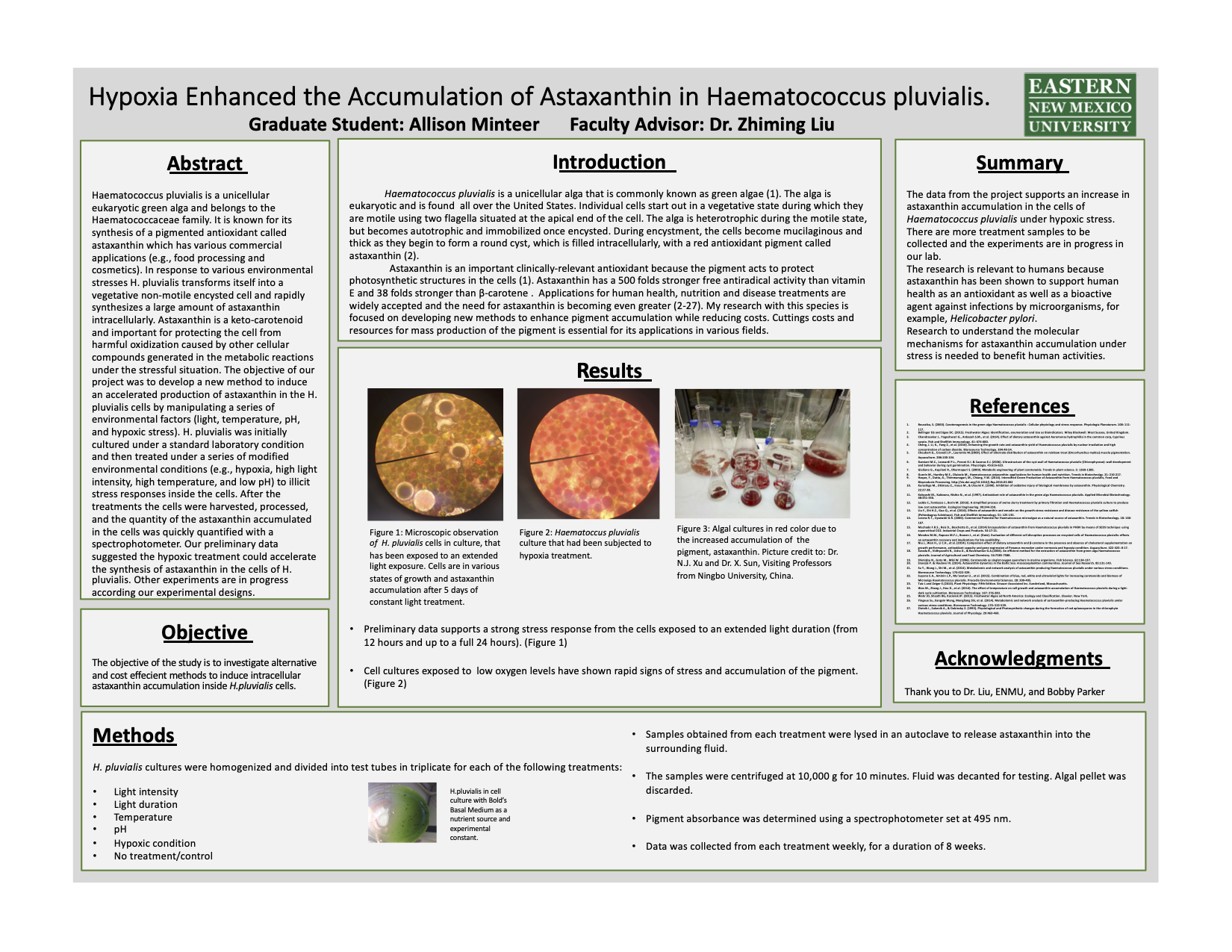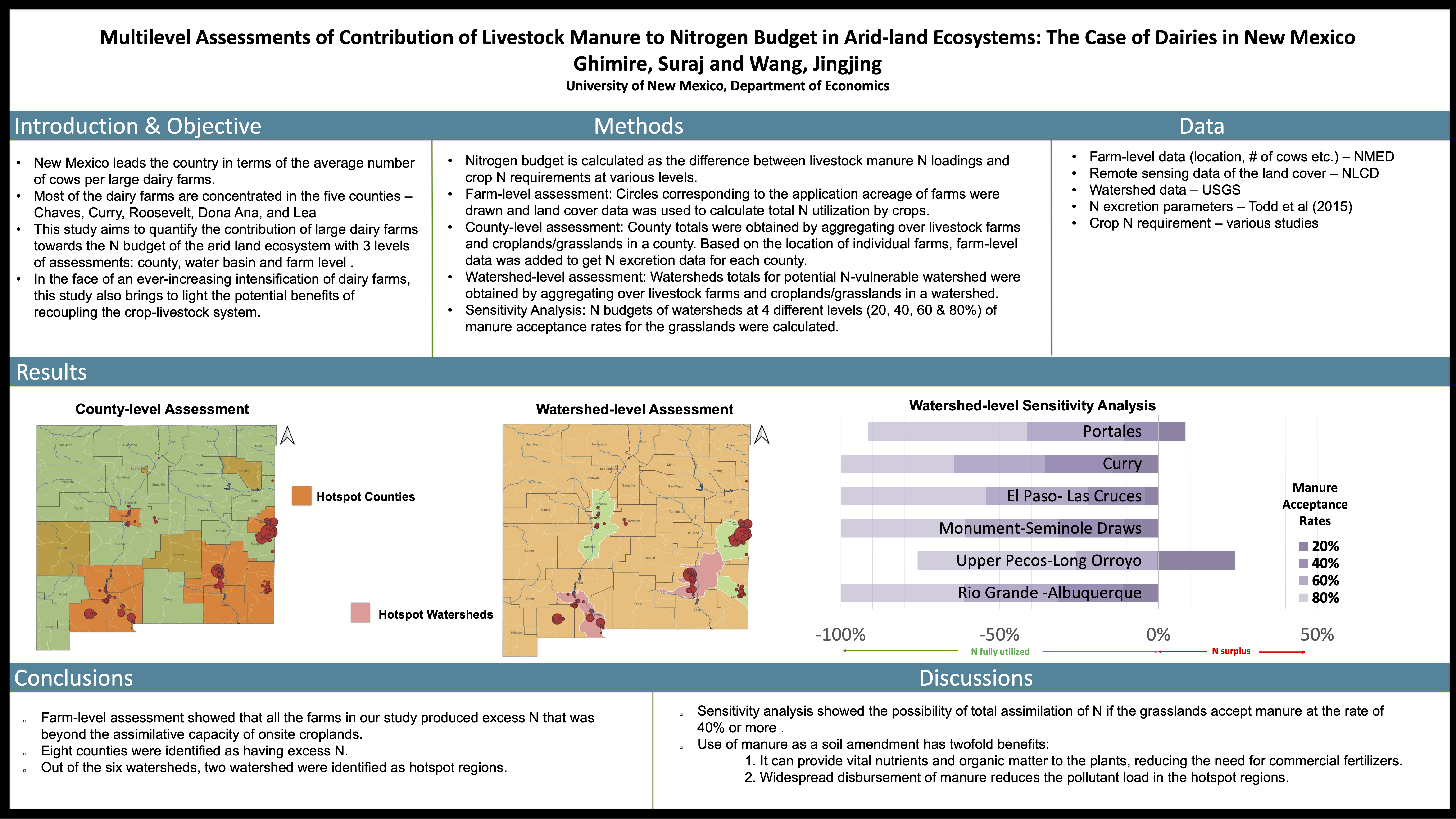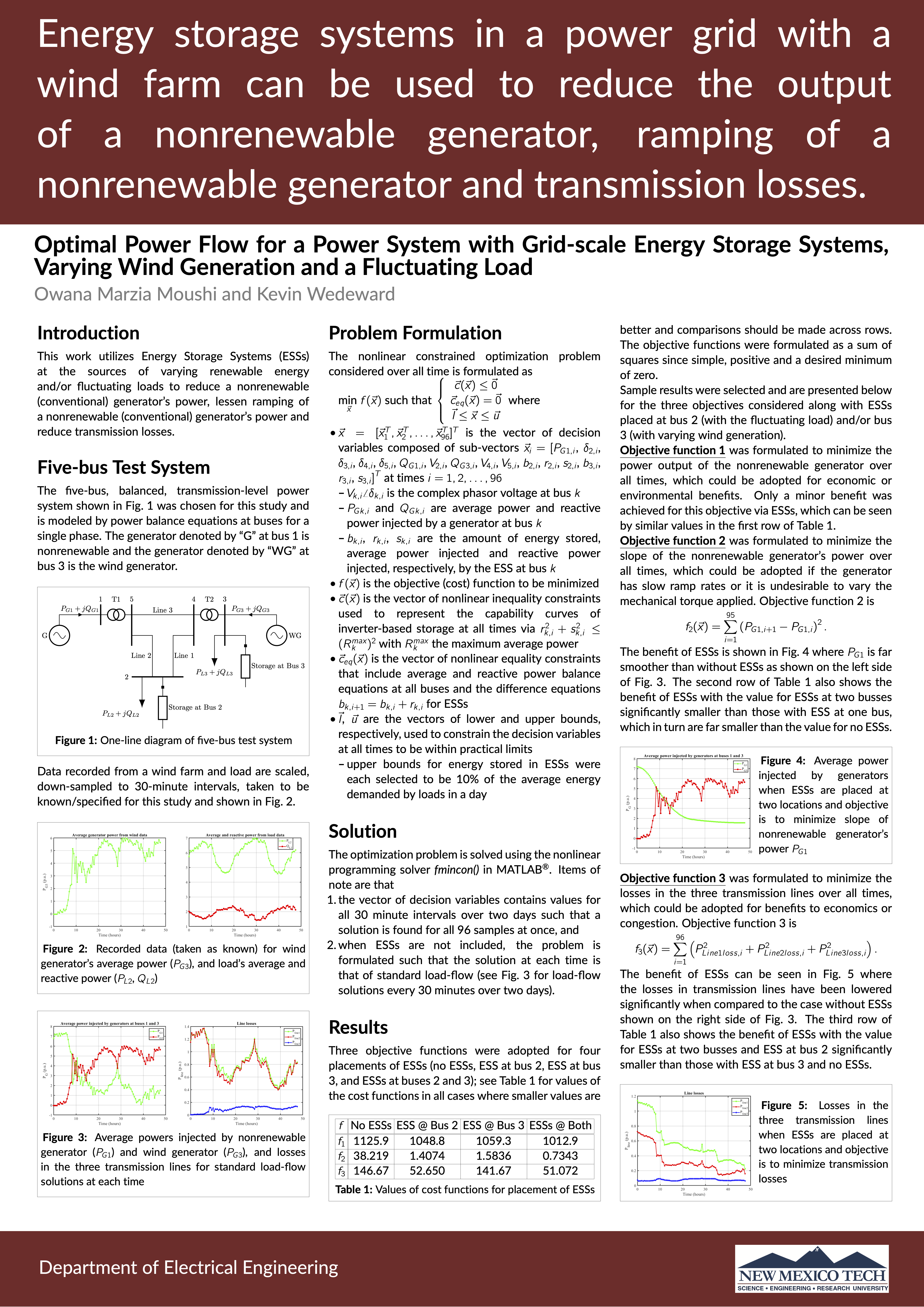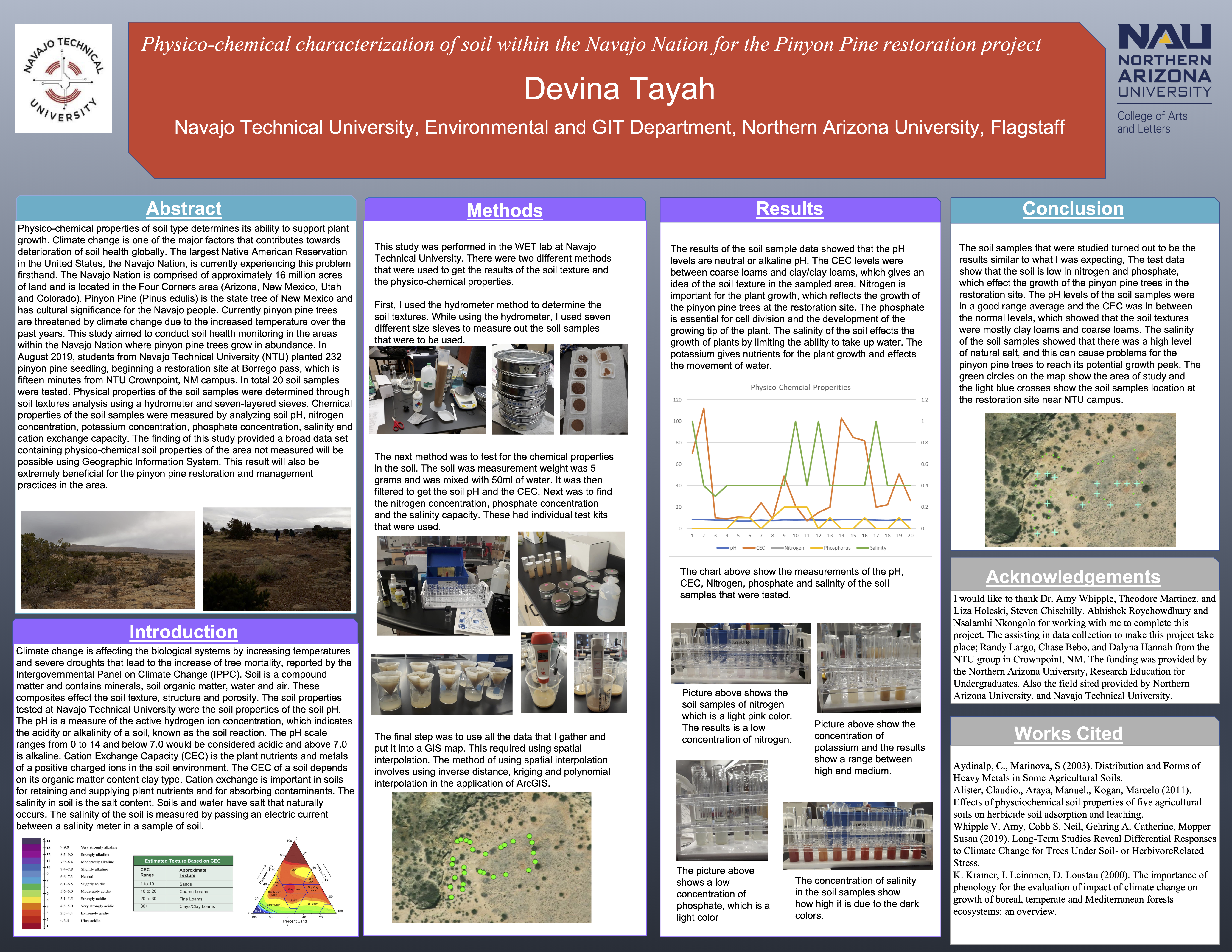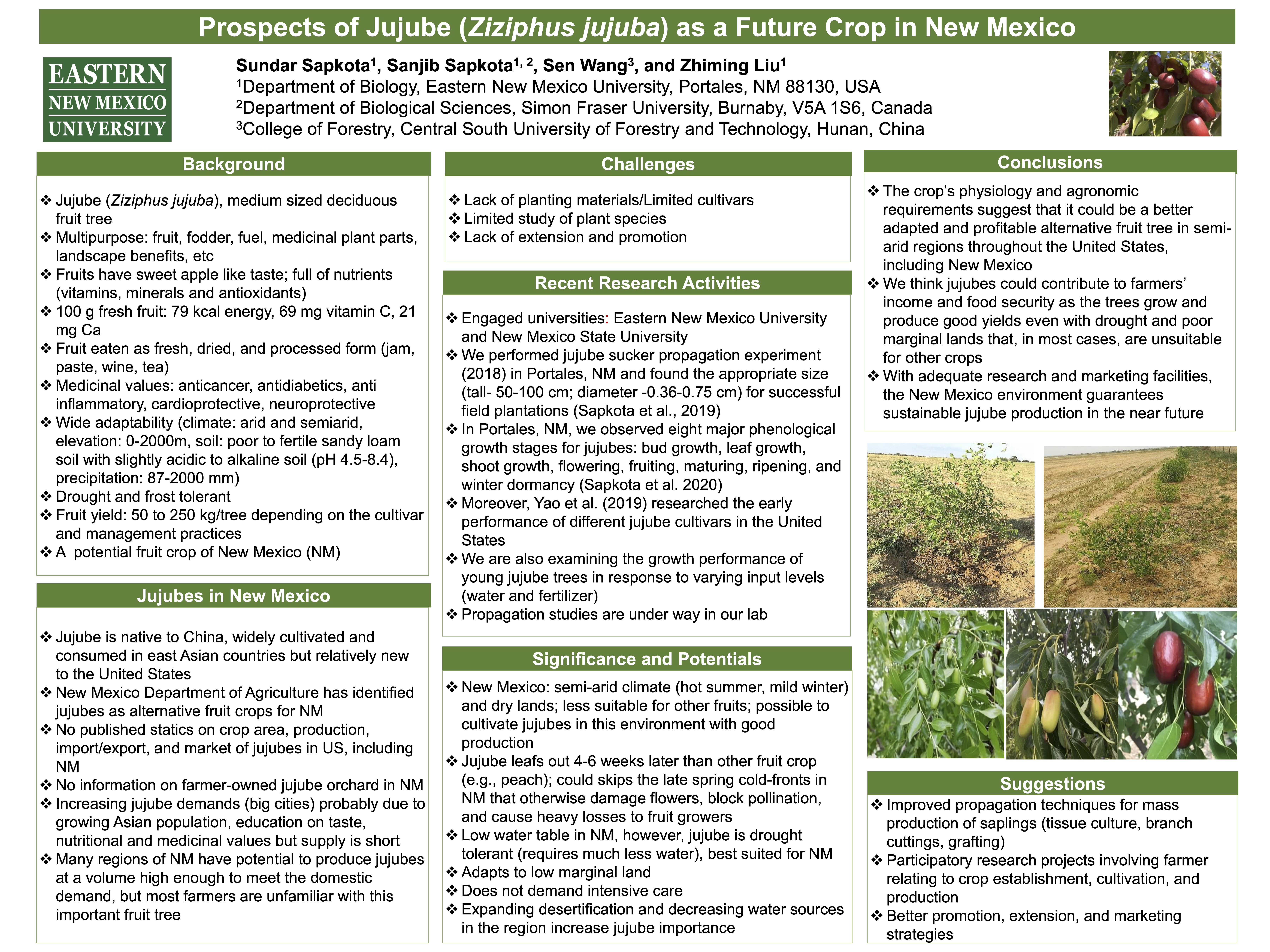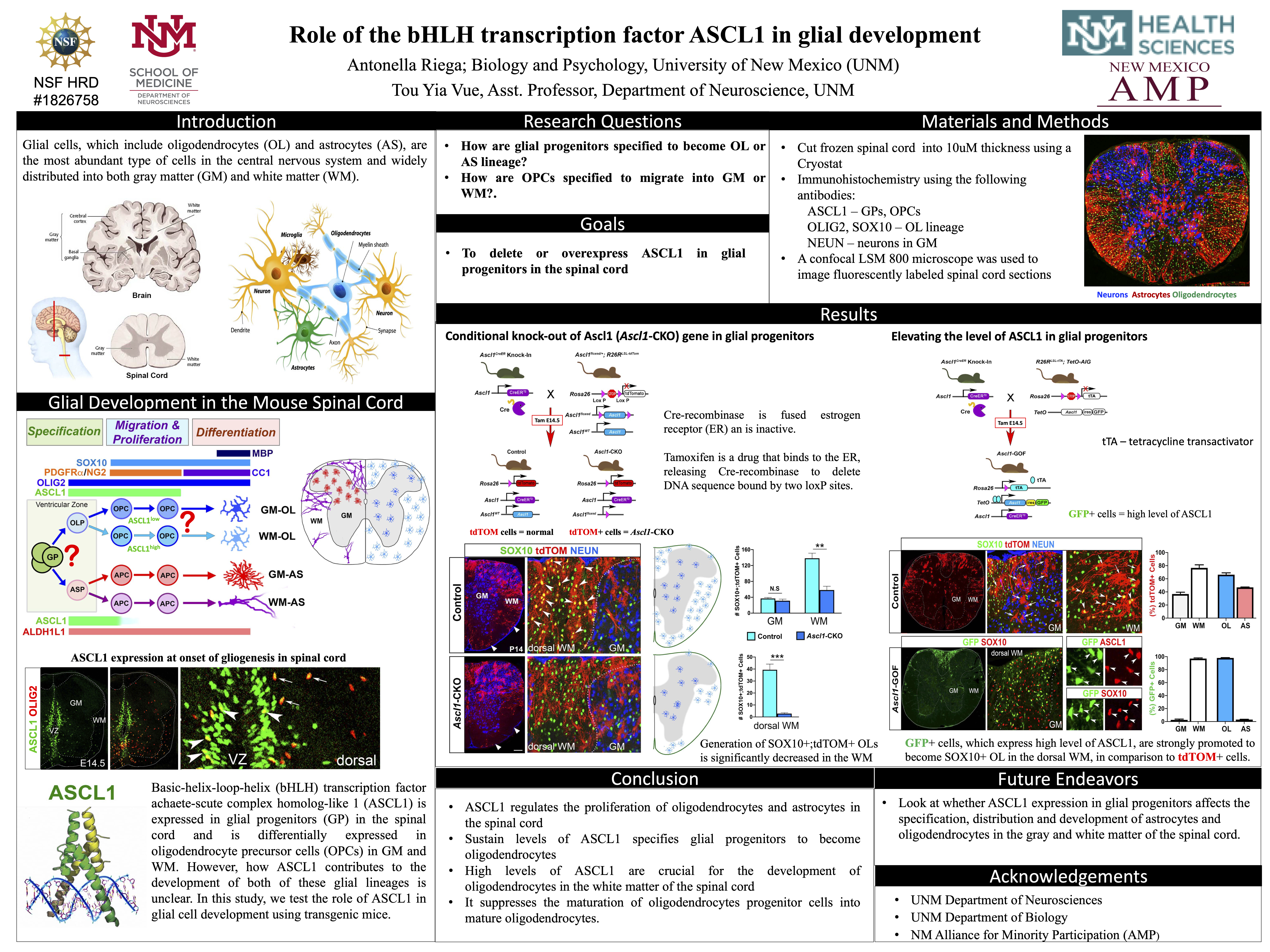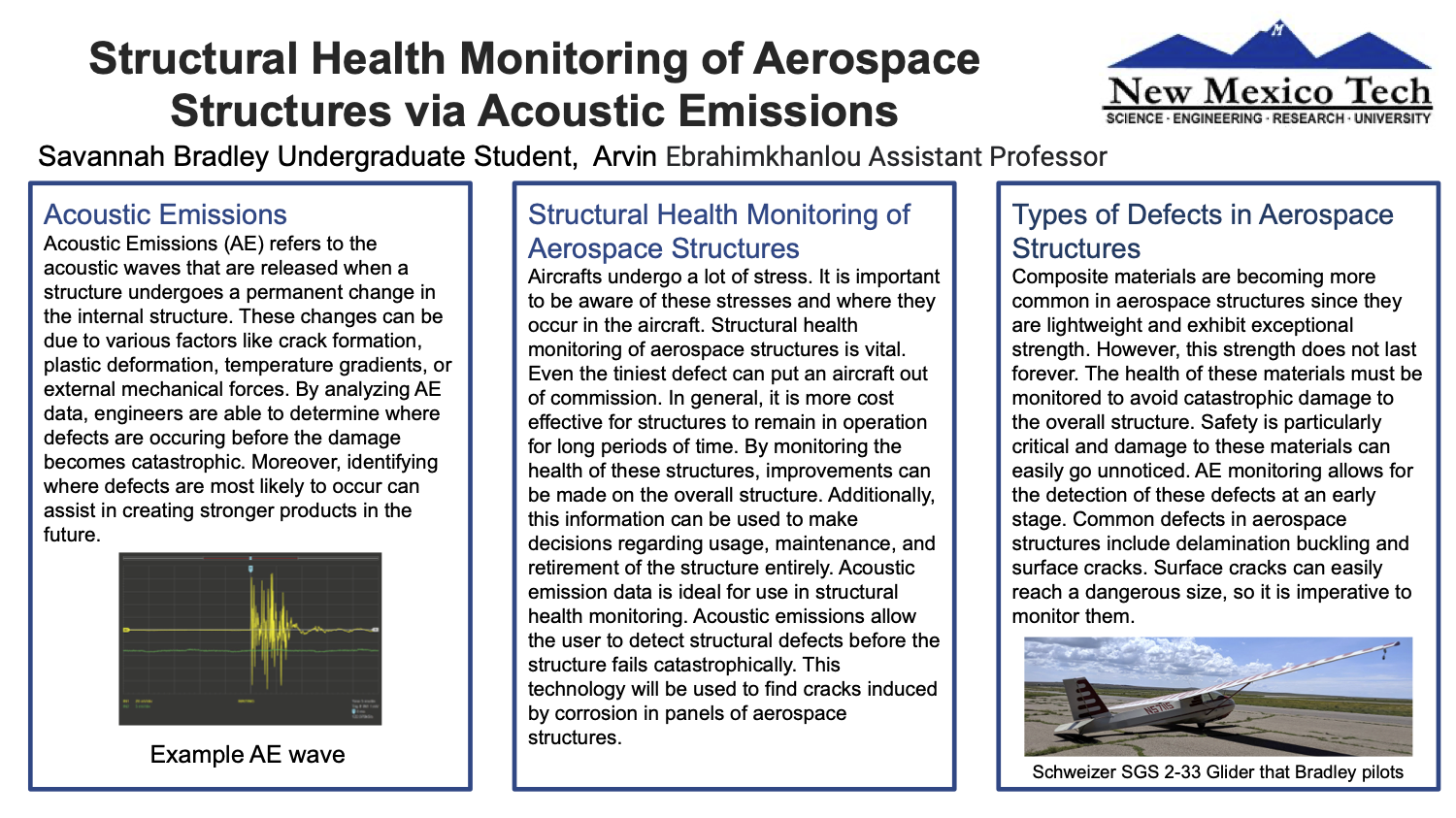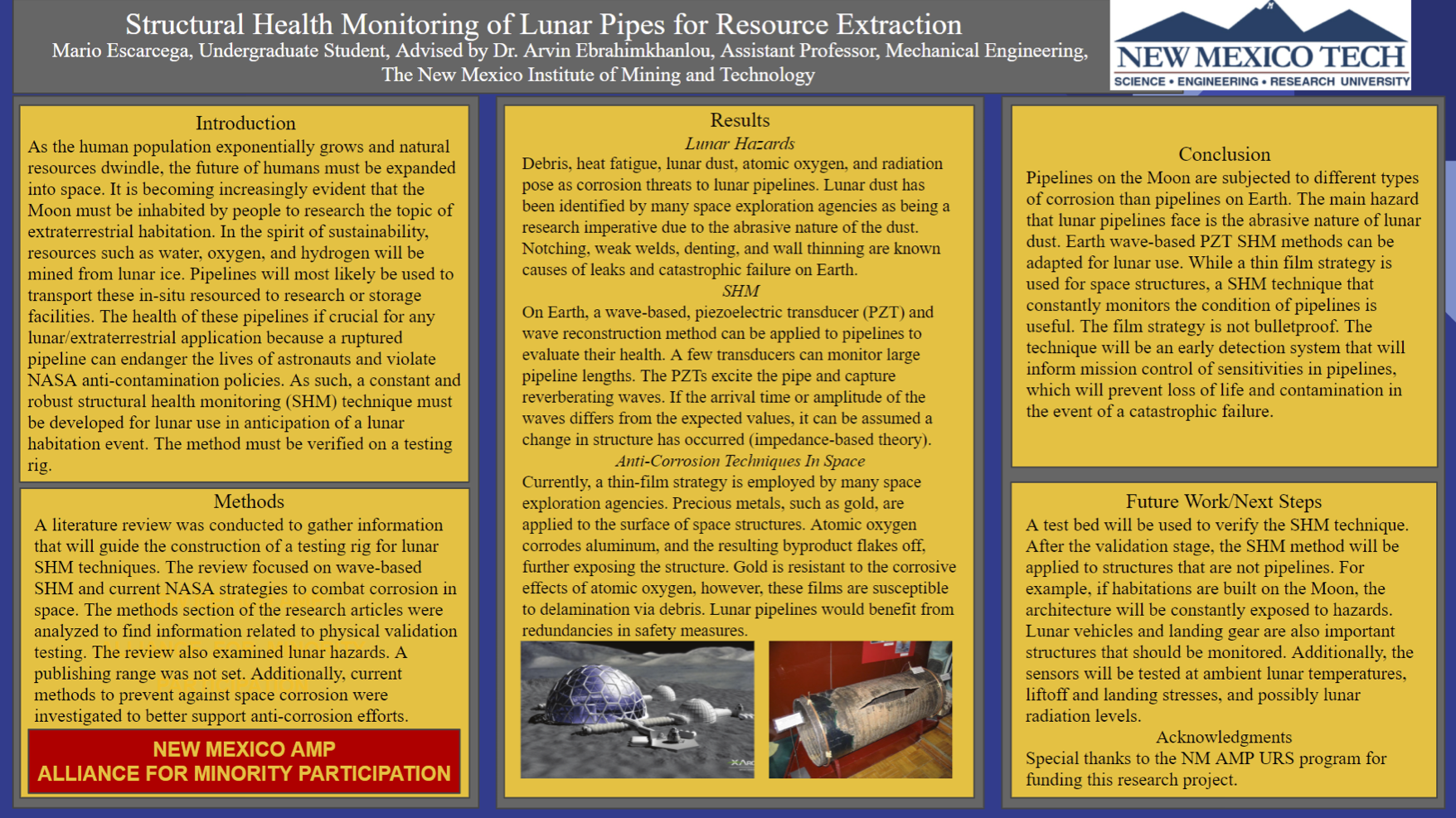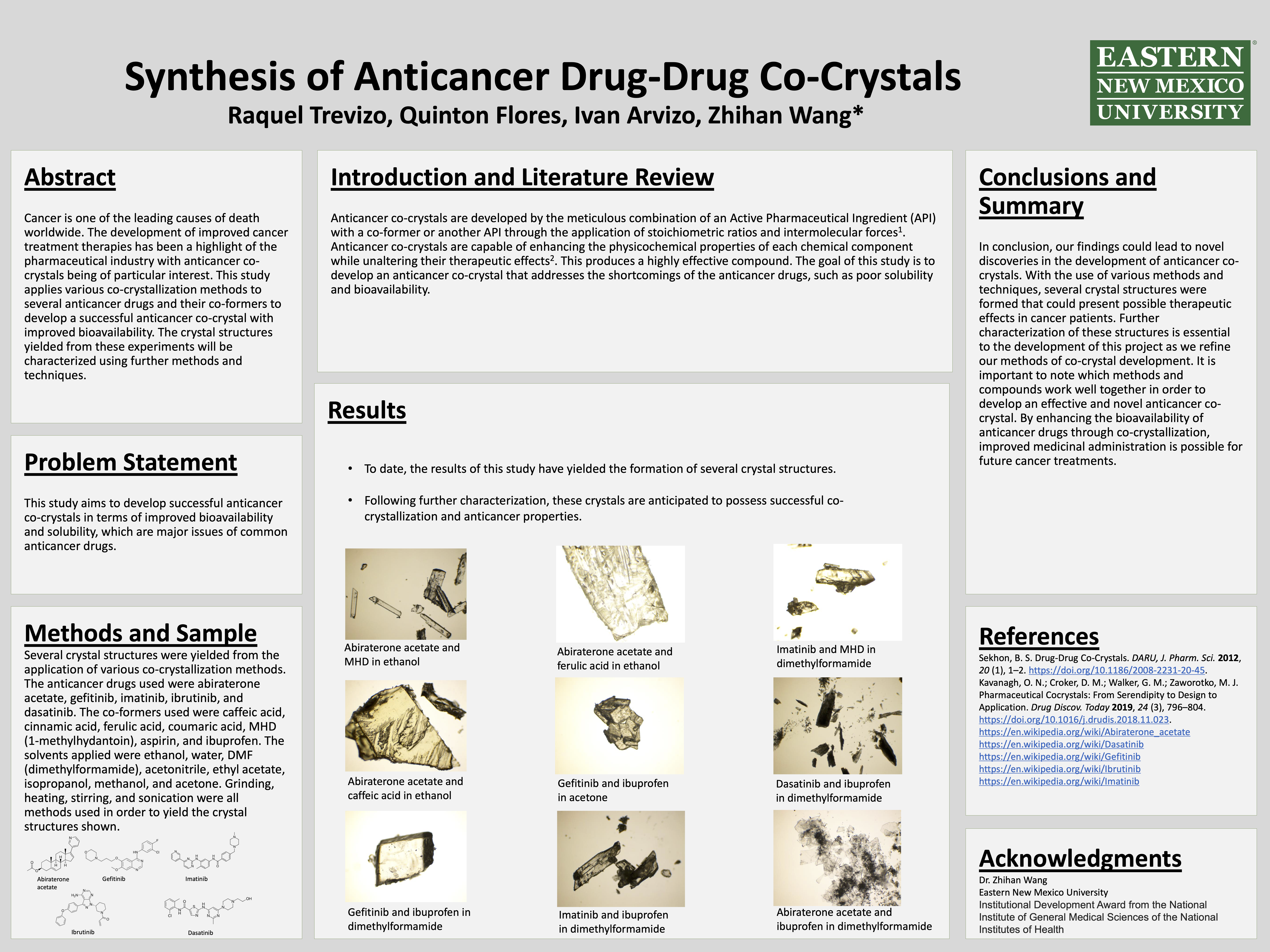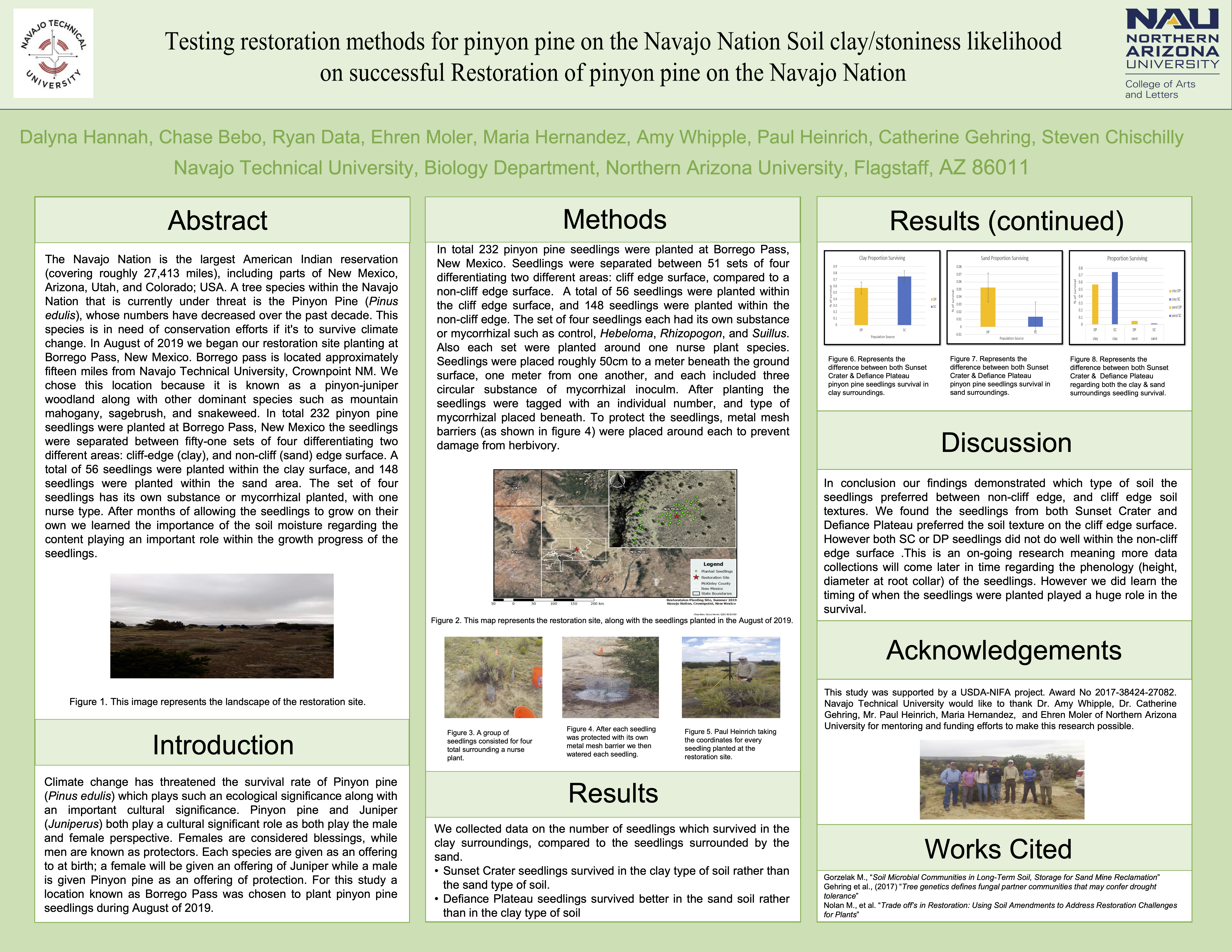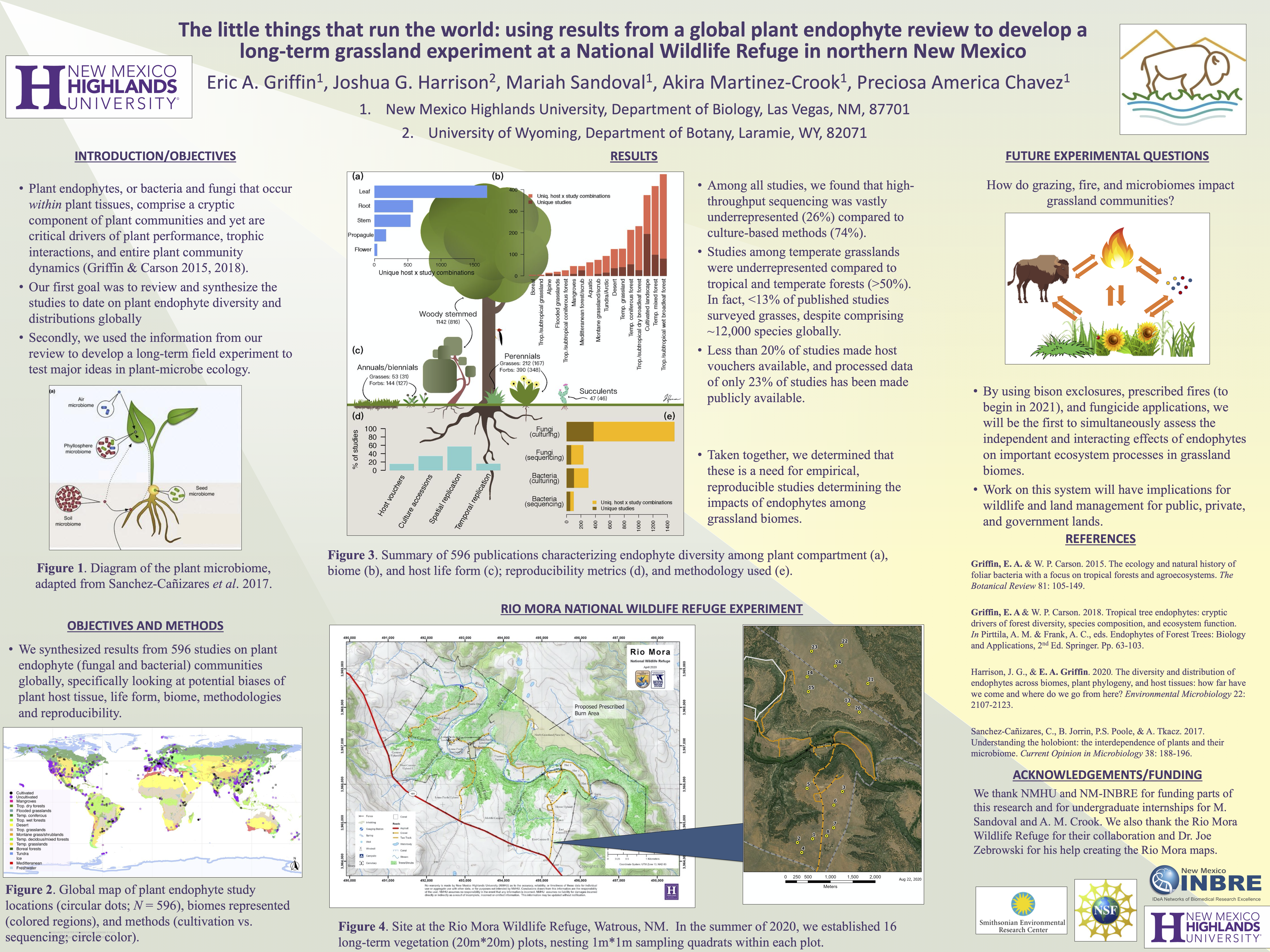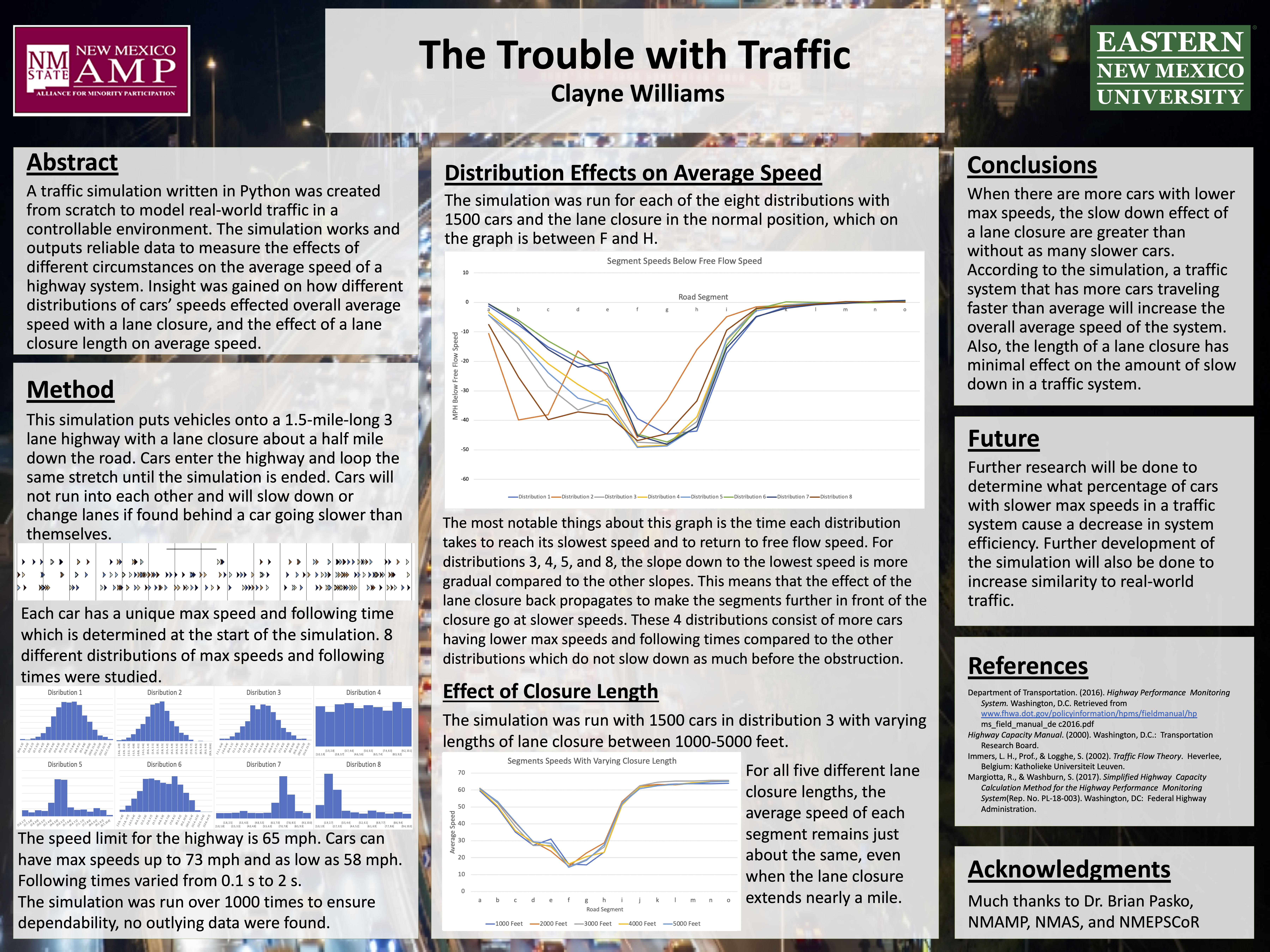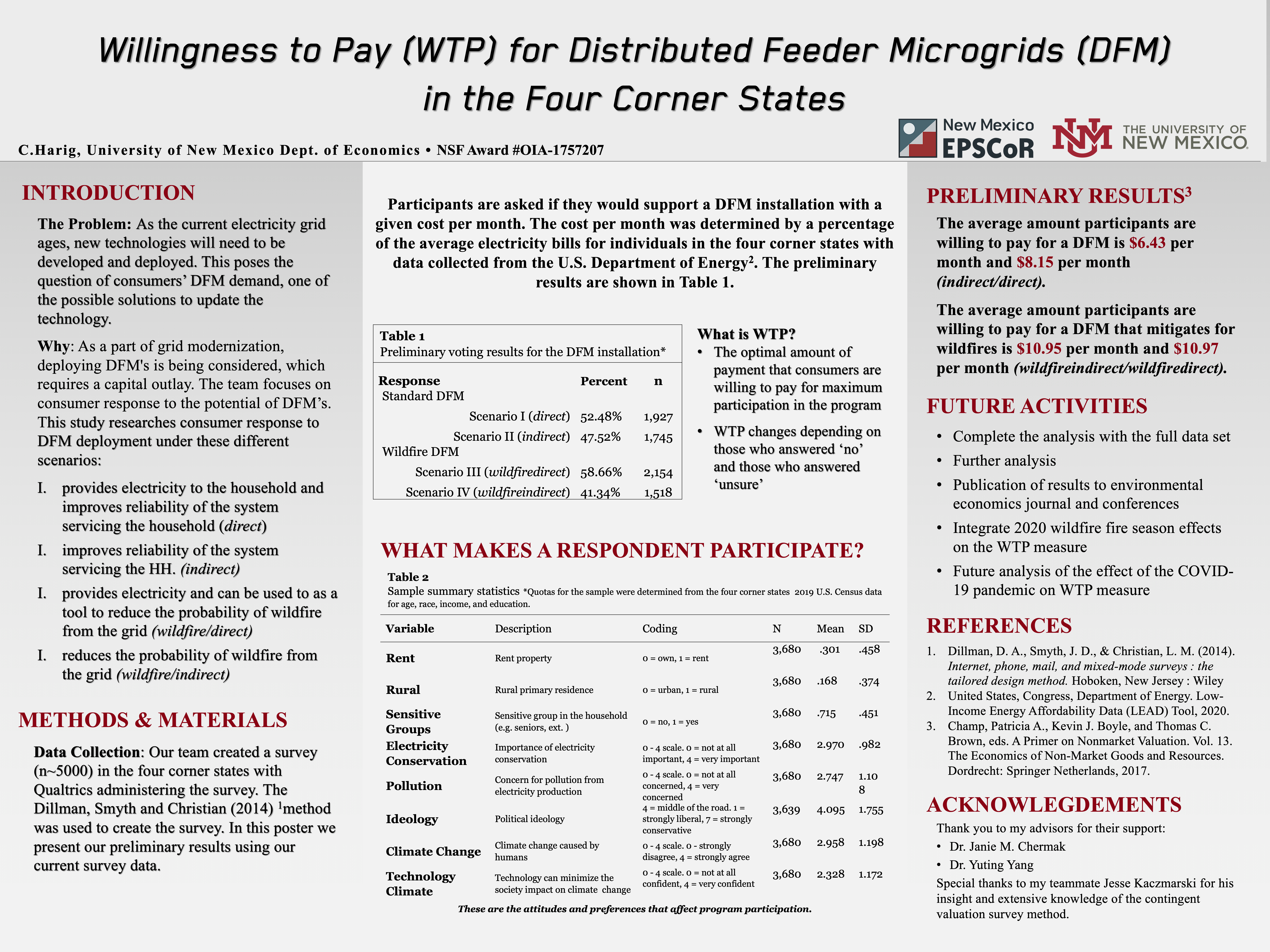NMRS 2020 Virtual Poster Session
Voting is now closed.A demonstration of traditional Navajo farming technique
Authors:
Phaizon Osborne
Institutions:
Navajo Technical University
Abstract:
Climate change is one of the major factors causing soil erosion and soil quality deterioration in the U.S. Overgrazing, deforestation, and unsustainable agricultural practices are equally responsible for the U.S. soil quality deterioration. Often compared in size to the state of West Virginia, the Navajo Nation has an area of over 27,000 square miles. Situated in the southwestern Colorado Plateau, the Nation‚s geography and topography are characterized by arid deserts, alpine forests with high plateaus, mesas, and mountains reaching up to 10,388 feet in altitude. Low desert regions have an altitude as low as 2,750 feet. Within this geography the Navajo people are dealing with serious environmental challenges, and one of them is associated with climate change-induced soil quality deterioration. Navajo culture integrates traditional ecological knowledge (TEK) that talks about maintaining a balance between Mother Earth and humankind. Traditional Navajo farming incorporates this knowledge and is an example of maintaining the harmony between humankind and nature. Absolutely no use of chemical fertilizers or pesticides is one of the environmental-friendly approaches of traditional Navajo farming technique. The way numerous First Nations including the Navajos do farming is not only beneficial to the environment, but the process can build topsoil with ancient heirloom seeds. The heirloom seeds are grown by Native Americans are known to be resilient and were bred to be nutritious. Heathy soil is especially important for many reasons; it not only increases yields dramatically but it also makes the food more nutrient-rich. The use of weeds or forbs as a mulch in the crop-field is a great way to start this process. Mulching helps water to be trapped on the ground for more effective use in a crop-field and making habitat for microorganisms that keep the plants heathy and resistant to diseases. This study applied TEK of Navajo farming while creating a garden on a 14-acre farmland owned and operated by traditional Navajo farmers in Nenahnezad, NM. The garden was made up of corn, bush beans, buckwheat, sunflowers, zinnias, watermelons, and sweat potatoes. The purpose of having different species in one spot was to mimic a forest environment if planted at the right time and place. A forest is made up of four or more layers of plantation: emergent, canopy, understory, and others. In this garden, corn played the role of canopy, sunflowers played the role of forest edge, the beans, buckwheat, and watermelons played the role of understory. The seeds were planted in Spring, 2020 and irrigation was done on a periodic basis. Plants‚ growth monitoring was conducted during this study. This study showed the traditional knowledge of seed selection and application of Navajo traditional framing practices are extremely useful in maintaining and managing highly vulnerable soil type of Navajo Nation. This rich traditional knowledge can also be applied to other parts of this country for the purpose of soil management.
Climate change is one of the major factors causing soil erosion and soil quality deterioration in the U.S.
Read MoreCategory:
Botany
Poster ID:
142219
A Machine Learning Model to Predict Groundwater Levels in the Mesilla Transboundary Aquifer
Authors:
Jacobo Giron,
Parth Nagarkar,
Kevin Perez,
Jonathan Montano,
Omid Jafari,
Khandker Mushfiqul Islam
Institutions:
New Mexico State University
Abstract:
The purpose of this research is to find the most effective way to forecast groundwater levels for wells in the Mesilla aquifer region of New Mexico. Although water level forecasting has many uses and applications, it is particularly useful in New Mexico. In 2015, New Mexico was home to 24,000 farms spanning 43.2 million acres. With more than 50% of the state's land being dedicated to agriculture, predicting groundwater levels allows municipalities to plan in terms of water conservation and allocation throughout residential and agricultural areas. In this work, we particularly focus on the Mesilla aquifer region of southern New Mexico, which is a transboundary aquifer between the US and Mexico under an intensive water use for agriculture and human consumption.
Recently, machine learning-related approaches have also shown great predictive capabilities in the field of water resources. Several works in this field have used state-of-the-art techniques based on Recurrent Neural Networks (RNNs) to predict groundwater levels by using historical data, such as groundwater levels and other weather-related attributes (e.g. Precipitation, temperature, etc.). We observe that the wells in the Mesilla aquifer region are uniquely positioned, and hence propose a machine learning technique that is enhanced using spatial analysis.
In this research work, we focused on using the state-of-the-art Recurrent Neural Networks called Gated Recurrent Units (GRU). We noticed better accuracy by using GRU instead of Long Short Term Memory (LSTM). We created a baseline model (called Model1) using a groundwater well with water levels dating back 775 months. This model was built with GRU using the Adam optimizer. Further, we included additional weather-related data, such as precipitation, temperature, depth from the top of the well to the water surface, and land surface elevation in the training model (called Model2). Finally, we performed spatial analysis on each well to improve the predictions of the previous models. With over 300 wells in the data, we sorted the distance of each well from the target well. We used the data from neighboring wells while training our model. After experimenting on different parameters (number of neighboring wells, amount of historical data to consider, number of weather-related attributes to choose from), we achieved the best results after using the data from five nearest wells, limiting the historical data to 10 years, and by using historical precipitation and temperature data along with the groundwater levels. We improved the accuracy (measured in terms of RMSE) of the baseline model by about 80% by integrating weather-related information and data from neighboring wells into the training model. For future work, we will focus on comparing our results with those using classical methods such as the modular finite-difference flow model (Modflow).
The purpose of this research is to find the most effective way to forecast groundwater levels for wells in the Mesilla aquifer region of New Mexico.
Read MoreCategory:
Economics and Analysis
Poster ID:
145796
A study on inheritance patterns on wing shape, body color and eye color in Drosophila melanogaster
Authors:
Unique Stock
Joshua Garcia-Matta,
Isabel Chavez,
Yusheng Wu
Institutions:
University of the Southwest
Abstract:
Due to its small size, short life cycle, abundance of genetic variability, and relative inexpensiveness, Drosophila melanogaster, the fruit fly, is used as the model organism. Mendelian traits studied in the project were eye color on chromosome 1 (sex-linked trait), vestigial-wing (on chromosome 2), ebony-colored body (on chromosome 3). For one-gene segregation, the flies with red eye were wild phenotype while white these with white eye were mutant phenotype. For two-gene segregation, the flies being full wing and normal body color were wild phenotype while these being vestigial wing and ebony body were mutant phenotype. The traits for two-gene segregation were wing and body color. The crosses and reciprocal crosses were produced for one-gene and two-gene segregations. The expected overall phenotypic ratios for one-gene segregation were 3 red eye : 1 white eye in the cross and 1 red eye female : 1 white eye female : 1 red eye male : 1 white eye male in the reciprocal cross. The expected overall phenotypic ratios for two-gene segregation were the same, 9:3:3:1. The results of œá2 statistical test for one-gene segregation didn‚t fit 3:1 ratio but fit 1:1:1:1 ratio. The results of œá2 statistical test for two-gene segregation didn‚t fit 9:3:3:1 ratio in both crosses. The explanations were given regarding the variations for different types of the crosses.
Due to its small size, short life cycle, abundance of genetic variability, and relative inexpensiveness, Drosophila melanogaster, the fruit fly, is used as the model organism.
Read MoreCategory:
Biology
Poster ID:
142223
Application of High-dimensional Data Analysis in Aerospace Structural Health Monitoring and Nondestructive Testing
Authors:
Hamed Momeni,
Arvin Ebrahimkhanlou
Institutions:
New Mexico Tech
Abstract:
Structural health monitoring is an evaluation technology to monitor aerospace structure using sensing systems such as accelerometers, ultrasound wave response, images, and videos. In this field, there are three major steps: damage detection, localization, and quantification. The data accused from numerous detectors are commonly high dimensional and highly correlated. A critical challenge is manipulating noisy and lossy data to compress, transfer, and retrieve. Furthermore, to diagnose and prognosis of the existing damage, the relevant and valuable features should be extracted to have a physical meaning or reasonable interpretation. This research reviewed high dimensional data analysis methods like functional data analysis, tensor-based data analysis, compressive sensing, and matrix completion. The previous applications in structural health monitoring and nondestructive testing for aerospace structures are presented, and the potential researches can take advantage of high dimensional analysis methods are proposed.
Structural health monitoring is an evaluation technology to monitor aerospace structure using sensing systems such as accelerometers, ultrasound wave response, images, and videos.
Read MoreCategory:
Economics and Analysis
Poster ID:
146040
Assessment of freshwater turtle populations on the Pecos River in New Mexico and Texas
Authors:
Laramie B. Mahan,
Lawrence G. Bassett,
Thanchira Suriyamongkol,
Michael R. J. Forstner,
Ivana Mali
Institutions:
Eastern New Mexico University,
Texas State University
Abstract:
Freshwater turtles represent vital components of aquatic and terrestrial ecosystems, providing many important ecological services (e.g., energy flow, seed dispersal, mineral cycling, etc.) Additionally, they can act as bioindicators of environmental health by accumulating chemicals that reside in their respective water systems. The Pecos River is one of the most anthropogenically altered rivers in the United States. Agricultural practices, dam construction, channelization, and petroleum production have significantly altered the river flow and overall water quality. These factors have long threatened the connectivity and viability of wildlife populations inhabiting the Pecos River system, including freshwater turtles. Yet, the Pecos River itself has not been properly surveyed for turtles in over a decade. In this study, we report preliminary results of freshwater turtle surveys across 16 sites on the Pecos River in New Mexico and Texas. For every survey, we deployed 45 hoop net traps for two consecutive days and surveyed each site three times between May and August 2020. Upon capture, turtles were marked, measured, and returned to the water. We additionally recorded water quality parameters such as pH, conductivity (µ/s), temperature (°C), flow (m/s), water depth (m), and water turbidity (m). Overall, we captured five species of turtles including Red-eared Slider (Trachemys scripta), Spiny Softshell turtle (Apalone spinifera), Yellow Mud turtle (Kinosternon flavescens), Common Snapping turtle (Chelydra serpentina), and New Mexico threatened Rio Grande Cooter (Pseudemys gorzugi). The species richness ranged from 0 to 5 species and the overall abundance ranged from 0 to 170 turtles per site. The most abundant and the most widely distributed species was Apalone spinifera while Chelydra serpentina was found at only one locality. Pseudemys gorzugi which is currently under review by the US Fish and Wildlife Service for potential federal protection was found at five locations: four in New Mexico and one in Texas. We captured only 11 unique P. gorzugi including 4 females, 6 males, and 1 juvenile. This work will continue and additional 16 sites will be surveyed in the summer of 2021. Our work will significantly contribute to our understanding of freshwater turtle distribution across this highly altered riverine system and aid in the assessment of conservation status of Pseudemys gorzugi.
Freshwater turtles represent vital components of aquatic and terrestrial ecosystems, providing many important ecological services (e.g., energy flow, seed dispersal, mineral cycling, etc.) Addition
Read MoreCategory:
Biology
Poster ID:
142156
Assessment of hantavirus prevalence among rodent communities in Eastern New Mexico
Authors:
Jaecy K. Banther,
Isaiah J. Moores,
Robert A. Nofchissey,
Thanchira Suriyamongkol,
Samuel Goodfellow,
Steven B. Bradfute,
Ivana Mali
Institutions:
Eastern New Mexico University,
University of New Mexico
Abstract:
Hantavirus is a zoonotic RNA virus that causes Hemorrhagic Fever with Renal Syndrome (HFRS) and Hantavirus Pulmonary Syndrome (HPS) in humans. Since the first reported case in the US in 1975, there have been approximately 118 HPS cases in New Mexico (NM). Since the majority of the cases are from northwestern NM, minimal attention has been given to the eastern portion of the state. However, the literature suggests there is a potential overlap of the Sin Nombre (SNV), El Moro Canyon, and Muleshoe virus in the eastern NM, and a recent study found six species tested positive for hantavirus antibodies. Here, we aim to investigate hantavirus antibody seroprevalence, identify hosts, and genetically confirm the viral strains across eight under surveyed counties in eastern NM. To date, we have surveyed 13 sites over 19,500 trap nights and captured 400 individuals belonging to two families: 32% Heteromyidae and 68% Cricetidae. Seven species we have captured are known hantavirus hosts. Species richness ranged from two to eight species per site, while capture per unit effort varied from 1% to 5%. Thus far we were able to test a subset of lung tissue samples of Peromyscus sp. and confirm the presence of SNV and non-SNV hantaviruses. In spring 2021, we will begin enzyme-linked immunosorbent assays (ELISA) to test blood samples for the presence of hantavirus specific antibodies and continue to genetically test individual positive lung samples for hantavirus strains. This study significantly expands our understanding of hantavirus species distribution, hantavirus prevalence among their respective hosts, and has a potential to illuminate any spillover events and/or discovery of novel hantaviruses.
Hantavirus is a zoonotic RNA virus that causes Hemorrhagic Fever with Renal Syndrome (HFRS) and Hantavirus Pulmonary Syndrome (HPS) in humans.
Read MoreCategory:
Biology
Poster ID:
142207
Collection of Pinus Edulis Cones throughout the Navajo Nation
Authors:
Chase Bebo
Institutions:
Navajo Technical University
Abstract:
The impact of climate change in the Navajo Nation has threatened one of its native plant species Pinyon Pine (Pinus edulis). A Pinyon pine restoration project aims to revegetate the areas lost due to the climate change. For this study pinyon pine cones were collected from five areas around the Navajo Nation. Pinyon pine cones that were green and closed were collected in order to ensure that they had viable seeds that could be used for the restoration project. Brown paper bags were used to store the cones and the tree ID number, coordinates, location, and the diameter of each tree were marked properly. The first area from where the cones were collected was Black Mesa near Kayenta, Arizona and Shonto, Arizona. At this site 40 cones were collected from 125 trees. The second area from where the cones were collected was Spider Rock near Canyon De Chelly in Arizona. Cones were collected from 28 trees at this site. The third site was Kinlechee, Arizona where the cones were collected from 15 trees. The fourth site was Defiance Plateau which is located on the outskirts of Widow Rock, Arizona and cones were collected from 3 trees at this site. The fifth and last site the cones were collected from was the restoration site at Borrego Pass, New Mexico. At this site cones were only collected from 1 tree as the pinyon pine trees at this site were not as abundant as the other collection sites. After the completion of the pinyon pine cone collection, the cones were let to sit in the brown paper bags that were used to store them in until they opened up. Once the cones were opened up, the extraction of each pinyon pine seed from the cones were done and separation of the hollow ones from the viable ones were performed. The seeds from the trees were stored inside properly labelled Ziploc bags. Finally, the seed containing bags were stored in a freezer to keep them viable for the pinyon pine restoration project. This study helped to develop collection of native variety of pinyon pine seeds that will be extremely useful for the pinyon pine restoration project in the Navajo Nation.
The impact of climate change in the Navajo Nation has threatened one of its native plant species Pinyon Pine (Pinus edulis).
Read MoreCategory:
Biology
Poster ID:
142297
Cooperative Dynamic Power Balancing and Smoothing in a Photovoltaic/Hybrid Energy Storage System Using Multiple Reactive Agents
Authors:
Seyyed Ali Ghorashi Khalil Abadi
Institutions:
University of New Mexico
Abstract:
Photovoltaic (PV) systems are one of the fastest-growing types of renewable energies that significantly contribute to the transformation of the global energy sector. Balancing the PV's generated power and load is essential to ensure the stability and enhance the reliability of the system. However, it is challenging due to the limitation on the availability of power and intermittency of generation. This challenge can be tackled by using hybrid energy storage systems (HESS). HESSs play an important role in dynamic power balancing; moreover, they are essential for the effective integration of PV Systems. The appropriate operation of HESS requires advanced control and management techniques. This research proposes a distributed hybrid control strategy for dynamic power balancing and smoothing in a photovoltaic (PV)/hybrid energy storage system. The system contains a PV system, a HESS including a battery energy storage and a supercapacitor, and a group of interconnected loads. Each system’s module is considered as a reactive agent that may change its state or operational mode upon satisfying a predefined condition. In the proposed approach there is no central controller or coordinator agent, and the decisions are made by the agents that directly communicate with each other. The interaction of the agents emerges a global pattern that provides a reliable and efficient power balancing and smoothing performance for the case study system. The simulation results show that the proposed control strategy can improve the system efficiency and performance by maintaining the balance between generation and load as well as reducing the required size of the supercapacitor.
Photovoltaic (PV) systems are one of the fastest-growing types of renewable energies that significantly contribute to the transformation of the global energy sector.
Read MoreCategory:
SMART Grid
Poster ID:
146606
Duplication history of the Piwi gene family in vertebrates
Authors:
Javier Gutierrez,
Micheal Vandewege
Institutions:
Eastern New Mexico University
Abstract:
Piwis are regulatory proteins that belong to the Argonaute gene family. Piwis are known to defend host genomes against transposable element (TE) mobilization in germline cells and use a class of small RNA, piRNA, as guides to TE transcripts and loci. The Argonaute family has members among all eukaryotes, but Piwis are only present in animals. Piwis are primarily expressed in gonadal tissues and protect inheritable genomes against the mobilization and propagation of TEs through transcript cleavage and TE methylation. Vertebrates genomes encode up to four Piwis named Piwil1, Piwil2, Piwil3 and Piwil4. Piwil1 and Piwil2 have been described in most animals, but Piwil3 and Piwil4 are specific to vertebrates and their duplication history is unresolved. Therefore, we leveraged phylogenetic, synteny and expression analyses to address this void. We collected Piwi DNA sequences from Ensembl 101 and NCBI from species representing all major vertebrate lineages. Piwi sequences were aligned and we constructed phylogenetic trees using IQTREE and ExaBayes. Our phylogenetic analysis suggests Piwil1 and Piwil2 were retained in all vertebrate members. Piwil4 was the result of Piwil1 duplication in the ancestor of gnathostomes, but was independently lost in ray-finned fishes and birds. Further, Piwil3 was also derived from a tandem Piwil1 duplicate in the common ancestor of marsupial and placental mammals. However, Piwil3 was secondarily lost in Afrotherians, Xenarthrans and mouse-like rodents. Interestingly, the evolutionary rate of Piwil3 is considerably faster than Piwil1, consistent with gene duplication models that predict relaxation of functional constraint and subsequent neofunctionalization. Further, several amino acid sites throughout the entirety of Piwil3 were evolving in a manner consistent with positive selection. Generally, gene order Piwil1, Piwil2, and Piwil4 has been conserved through vertebrate evolution, even around the Piwil4 locus in birds and ray-finned fish that lost Piwil4. The position of Piwil3 has been less conserved during mammalian evolution and can be bordered by a diversity of genes. Lastly, our expression analyses suggest Piwi expression has mostly been constrained to gonads throughout vertebrate evolution, consistent with previous analyses. Vertebrate evolution is marked by two rounds of whole genome duplication and many multigene families can be linked to this event. However, our analyses suggest Piwi duplications were independent of these events. Further, teleost fishes lack any additional Piwi paralogs despite an independent round of whole genome duplication. The loss of Piwil4 in birds and ray-finned fishes is interesting because Piwil4 is linked to preventing TE mobilization through DNA methylation. TEs are silenced at CpG sites in mammals but CpG islands are largely un-methylated in birds. It is hypothesized methylating TEs creates a non-lethal relationship between TEs and host genomes by allowing the retention of insertions that would otherwise be purged by natural selection. Piwil4 is present in other reptiles and reptilian TEs are not methylated at CpG sites, however a there could be a possible link between the loss of Piwil4 and TE reduction in birds worthy of further investigation.
Piwis are regulatory proteins that belong to the Argonaute gene family.
Read MoreCategory:
Biology
Poster ID:
142218
Effects of Water and Fertilizer Application on Jujube Growth in New Mexico
Authors:
Sundar Sapkota,
Sanjib Sapkota,
Sen Wang,
Zhiming Liu
Institutions:
Eastern New Mexico University, USA,
Simon Fraser University, Canada,
Central South University of Forestry and Technology, China
Eastern New Mexico University, USA
Abstract:
Jujube is a perennial tree primarily planted for edible fruits. The crop is famous in Asia but relatively unknown to the United States. Prospects of jujubes as an alternative future crop in New Mexico are increasing but the lack of proper extension and promotion caused many farmers to be unknown with the crop. Also, the lack of saplings and field-based research information have restricted its cultivation in New Mexico. Thus, we performed field experiments (2019 and 2020) to investigate water and fertilizer influence on jujube growth performance. For this study, we applied three levels of water (2: low, 8: medium, and 16 L: high), and fertilizers (35: low, 70: medium, and 140 g: high) to jujube plants. Control treatments did not receive any amount of water and fertilizer. Variables such as increment in plant height, stem diameter, number of leaves, leaf sizes, and chlorophyll contents were recorded. The 16 L water and 70 g fertilizer increased plant height and diameter by 60.1 cm and 5.23 mm in 2019, and 67.81 cm and 6.18 mm in 2020, respectively. Leaf length and width under W3F2 were 5.68 cm and 2.80 mm in 2019, and 5.85 cm and 2.98 mm in 2020, respectively. Similar trend was found in terms of leaf number. Leaf chlorophyll concentration was also positively influenced by water-fertilizer application. Based on the findings of our research project, we recommend 16 L water and 70 g NPK fertilizers per plant in young jujube orchards in order to maximize growth. This information guides farmers to adopt better water fertilizer management strategies in the orchards to enhance crop performance. These findings might encourage farmers to consider jujubes as an alternative crop in New Mexico.
Jujube is a perennial tree primarily planted for edible fruits. The crop is famous in Asia but relatively unknown to the United States.
Read MoreCategory:
Botany
Poster ID:
142170
Geospatial Analysis of Black Mesa's Pinyon Pine Trees Growth Parameters.
Authors:
Randy Largo
Institutions:
Navajo Technical University
Abstract:
Navajo Nation is facing many environmental issues related to climate change. Degradation of Pinyon Pine (Pinus edulis) forests, among other native plant species, is one of such major on-going environmental challenges for the Navajo Nation. Pinyon pines have ecological and cultural significance for the Navajo people. The objective of this study was to quantify Pinyon Pine trees growth parameters such cones, height and diameter in order to assess Pinyon Pine forest‚s health and productivity. The study was conducted in Black Mesa located in the northeast region of the state of Arizona and within the Navajo Nation Reservation. Black Mesa is mostly a forest of Pinyon Pine, Juniper, Ponderosa Pine, and Oak. This environment has sandy shrub land of black sage and snake weed in open fields which are scattered across Black Mesa. We mapped the area of the study and sampled approximately 175 pinyon pine trees. For each tree, we collected and counted cones. Tree height was simultaneously recorded and its diameter at breast height (dbh) measured using a slide caliper. The geographic coordinates (latitude and longitude) of each three location were recorded using a Garmin handheld GPS. The collected data was transferred into MS-Excel then to ARCGIS ‚Äì ARCMAP 10.8 for mapping and geospatial analysis. Results showed that the cones, diameter and tree height varied from 40 to 50; 5 to 61 cm and 160 to 985 cm, respectively. The coefficients of variation (CV) were 3.09% for cones, but 43% for diameter and height suggesting that these tree growth parameters had a high variability. Maps portraying the spatial distribution of trees showed a cluster of pinyon pines in the northern side of the study field. Further geostatistical analysis confirmed the high variability of tree diameter and height of pinyon pine trees across Black Mesa. The results of this study will be very useful for the implementation of pinyon pine management in this area.
Navajo Nation is facing many environmental issues related to climate change.
Read MoreCategory:
Botany
Poster ID:
142243
Hierarchical Structure of Microgrid Control Systems
Authors:
Joshua May
Institutions:
Central New Mexico Community College,
University of New Mexico
Abstract:
This poster describes the Hierarchical Structure of microgrids, the role of each control section, and a few examples of how to further one's knowledge and understanding of micro grids. This poster is the result of a two-month research project to learn the rudimentary principles of the Hierarchical Structure of microgrids and is from the level of an undergraduate. Micro grids, according to the center for climate and energy solutions, provide less then 0.2 percent of power in the United States but can be one of the most revolutionary ways to manage, sustain, and deliver power. The efforts with this program are attempting to bring micro grids to New Mexico to help change its power systems for the better. My research partner Althea and I spent the summer being mentored by Dr. Bidram in which he gave us papers to read and research. Part of the outcome of that program was this poster! With the knowledge I have learned from this and the curiosity, it has led me to participate in the stemap plus program to delve more into microgrids and its cyber security aspect for the next year.
This poster describes the Hierarchical Structure of microgrids, the role of each control section, and a few examples of how to further one's knowledge and understanding of micro grids.
Read MoreCategory:
SMART Grid
Poster ID:
142184
How the Built Environment Can Help Employees to Experience Lower Occupational Stress
Authors:
Hirbod Norouzianpour
Institutions:
University of New Mexico
Abstract:
Stress affects every persons‚ health and well being, significantly and vastly. Occupation stress negative effects are bolder in workplaces; both as a disease agent and as an obstacle to employee's productivity and satisfaction. Although occupational stress has various sources, and designers have no control over many of them, there is a group of interventions that are design related. In this research, those design strategies to mitigate stress are considered as environmental interventions. The literature on occupant health, well-being, satisfaction, and productivity are huge and multi-directional; however, this research is limited to stress factors that correlated with the built environment and focus on employees who are experiencing a high rate of stress in office buildings as the target group. Due to that, the researcher finds evidence of environmental interventions that can reduce stress or enhance the stress-coping abilities of workers in offices by design and environmental health improvement. The questions that this research is answering are; what are the main environmental factors in offices that can help the employees experience lower stress or help them to mitigate the stress after facing it? How can space cause people to stress? How do stress and built environment collaborate? This research is based on the cross-disciplinarily systematic literature review of architecture, planning, public health, medical, management, and psychological sciences. The outcome of this research is the set of strategies to provide solutions for healthier and productive working places in offices with a concentration on the reduction of the stress level of employees, which can be used as a source for workplace evidence-based designs. These strategies are discussed in three realms: urban, architecture, and conjunction area as a mediator between outside and inside.
Stress affects every persons‚ health and well being, significantly and vastly.
Read MoreCategory:
Economics and Analysis
Poster ID:
142255
Hypoxia Enhanced the Accumulation of Astaxanthin in Haematococcus pluvialis
Authors:
Allison Minteer,
Zhiming Liu
Institutions:
Eastern New Mexico University
Abstract:
Haematococcus pluvialis is a unicellular eukaryotic green alga and belongs to the Haematococcaceae family. It is known for its synthesis of a pigmented antioxidant called astaxanthin which has various commercial applications (e.g., food processing and cosmetics). In response to various environmental stresses H. pluvialis transforms itself into a vegetative non-motile encysted cell and rapidly synthesizes a large amount of astaxanthin intracellularly. Astaxanthin is a keto-carotenoid and important for protecting the cell from harmful oxidization caused by other cellular compounds generated in the metabolic reactions under the stressful situation. The objective of our project was to develop a new method to induce an accelerated production of astaxanthin in the H. pluvialis cells by manipulating a series of environmental factors (light, temperature, pH, and hypoxic stress). H. pluvialis was initially cultured under a standard laboratory condition and then treated under a series of modified environmental conditions (e.g., hypoxia, high light intensity, high temperature, and low pH) to illicit stress responses inside the cells. After the treatments the cells were harvested, processed, and the quantity of the astaxanthin accumulated in the cells was quickly quantified with a spectrophotometer. Our preliminary data suggested the hypoxic treatment could accelerate the synthesis of astaxanthin in the cells of H. pluvialis. Other experiments are in progress according our experimental designs.
Haematococcus pluvialis is a unicellular eukaryotic green alga and belongs to the Haematococcaceae family.
Read MoreCategory:
Biology
Poster ID:
142187
Multilevel Assessments of Contribution of Livestock Manure to Nitrogen Budget in Arid-land Ecosystems: The Case of Dairies in New Mexico
Authors:
Suraj Ghimire
Institutions:
University of New Mexico
Abstract:
Multilevel Assessments of Contribution of Livestock Manure to Nitrogen Budget in Arid-land Ecosystems: The Case of Dairies in New Mexico
The livestock industry is one of the major contributors to nitrogen pollution. Nearly one-third of the global human-induced nitrogen emissions are contributed by this sector. The intensification of dairy farms has resulted in an oversupply of nitrogen in smaller land pockets causing degradation of environmental and human health. New Mexico leads the country in terms of the average number of cows per large dairy farms and has held this position since 2002. A study by Johnson et al. (2003) indicates that nearly two-thirds of the New Mexican dairies have improper management of manure leading to groundwater pollution. This study aims to quantify the contribution of large dairy farms towards the nitrogen budget of the arid land ecosystem and recommend optimal abatement strategies. The nitrogen budget is calculated as the difference between livestock manure nitrogen loadings and crop nitrogen requirements. First, we modeled the spatial distribution of large dairy farms in New Mexico based on herd and land sizes and performed a farm-level assessment. For this, circles corresponding to the application acreage of farms were drawn and land cover data were used to calculate total nitrogen utilization by crops. For the county-level assessment, county totals were obtained by aggregating over livestock farms and croplands/grasslands in a county. Based on the geocoded locations of dairy and the number of cows in each farm, nitrogen excretion values were assigned to each county. Then, we performed a water-shed level assessment by aggregating over livestock farms and croplands/grasslands in the vulnerable watersheds. Results showed that eight counties, six watersheds, and all the farms at the individual level had excess nitrogen beyond the assimilative capacity of croplands. Then we proposed to include rangelands as possible sinks and performed a sensitivity analysis to understand the variation in nitrogen budget at 20, 40, 60, and 80% willingness to accept levels. Findings indicated that at 40% and above acceptance rate, all the excreted nitrogen can be assimilated within the system. Therefore, the integration of the crop-livestock system with the rangelands can provide a viable solution to reduce the nutrient loadings in air, soil, and water and provide affordable commercial fertilizer substitutes for the farmers and ranchers.
Multilevel Assessments of Contribution of Livestock Manure to Nitrogen Budget in Arid-land Ecosystems: The Case of Dairies in New Mexico
Read MoreCategory:
Economics and Analysis
Poster ID:
142360
Optimal Power Flow for a Power System with Grid-scale Energy Storage Systems, Varying Wind Generation and a Fluctuating Load
Authors:
Owana Marzia Moushi,
Kevin Wedeward
Institutions:
New Mexico Tech
Abstract:
As the amount of variable renewable energy integrated into power systems continues to increase around the world, energy storage systems (ESS) hold the promise of enabling larger amounts of renewable energy to be accommodated and providing additional flexibility in the power system‚s operation. This poster presents an approach based on optimal power flow to improve the performance of a power system with wind generation through the addition of ESS. The placement of the ESS is considered at the site of varying wind generation and/or location of a fluctuating load, and enables an increase in performance of the power system to be achieved over a period of time. Objectives considered for improvements in performance include reduction of a conventional (nonrenewable) generator‚s output power, smoothing of a conventional generator's output power to lessen ramping, and reduction in transmission losses. A single-phase, transmission-level model of a five-bus power system was selected to serve as the test system, which includes a conventional generator, a wind generator with varying power output specified by recorded data, a fluctuating load specified by recorded data, a fixed load, and ESS placed at the varying wind generator and/or fluctuating load. Values from both the varying wind generation and fluctuating load were scaled to be consistent with the five-bus test system and down sampled such that values are given at 30-minute intervals for two days. ESS are sized at 10% of the daily demand for energy, and are modeled by first-order difference equations that relate the rate (average power) of charge/discharge and amount of energy stored at every step. With selected data specified at each time, an optimal load flow problem was formulated and solved (via constrained nonlinear optimization algorithms) over all 96 time steps. The case of load flow with no ESS present served as the baseline to which three scenarios (ESS co-located with wind generation, ESS co-located with fluctuating load, and ESS at both locations) were considered for each of the three objectives such that there were nine results. In all scenarios the performance of the power system is improved as expected with the selected objective. The improvements can be viewed qualitatively in figures of the conventional generator‚s power and line powers, and quantitatively through values calculated for the objective functions (metrics) in all scenarios. As is likely intuitive, the best results are achieved for ESS placed at two locations followed closely by a single installation of ESS at the bus with fluctuating load. The approach and associated results demonstrate examples of improvements that can be achieved in a power system‚s performance through integration of ESS along with renewable energy. An additional impact is that insight into the preferable location and size of ESS can be determined based upon the desired objective.
As the amount of variable renewable energy integrated into power systems continues to increase around the world, energy storage systems (ESS) hold the promise of enabling larger amounts of renewabl
Read MoreCategory:
SMART Grid
Poster ID:
142247
Physico-chemical characterization of soil within the Navajo Nation for the Pinyon Pine restoration project
Authors:
Devina Tayah
Institutions:
Navajo Technical University
Abstract:
Physico-chemical properties of a soil type determines its ability to support plant growth. Climate change is one of the major factors that contributes towards deterioration of soil health globally. The largest Native American Reservation in the United States, the Navajo Nation, is currently experiencing this problem firsthand. The Navajo Nation is comprised of approximately 16 million acres of land and is located in the Four Corners area (Arizona, New Mexico, Utah, and Colorado). Pinyon Pine (Pinus edulis) is the state tree of New Mexico and has cultural significance for the Navajo people. Currently pinyon pine trees are threatened by climate change due to the increased temperature over the past years. This study aimed to conduct soil health monitoring in the areas within the Navajo Nation where pinyon pine trees grow in abundance. In August 2019, students from Navajo Technical University (NTU) planted 232 pinyon pine seedlings, beginning a restoration site at Borrego pass, which is fifteen minutes from NTU Crownpoint, NM campus. The seedlings of the pinyon pine were separated into four sets and planted in different areas at the restoration site. In total 20 soil samples were tested. Physical properties of the soil samples were determined through soil textures analysis using a hydrometer and seven-layered sieves. Chemical properties of the soil samples were measured by analyzing soil pH, nitrogen concentration, potassium concentration, phosphate concentration, salinity, and cation exchange capacity. The findings of this study provided a broad data set containing physico-chemical soil properties of the area which was previously untested. With this data collected soil texture determination of the areas not measured will be possible using Geographic Information System. This result will also be extremely beneficial for the pinyon pine restoration and management practices in the area.
Physico-chemical properties of a soil type determines its ability to support plant growth.
Read MoreCategory:
Botany
Poster ID:
146135
Prospects of Jujube (Ziziphus jujuba) as a Future Crop in New Mexico
Authors:
Sundar Sapkota,
Sanjib Sapkota,
Sen Wang,
Zhiming Liu
Institutions:
Eastern New Mexico University, USA,
Simon Fraser University, Canada,
Central South University of Forestry and Technology, China
Eastern New Mexico University, USA
Abstract:
Jujube is a multipurpose fruit tree belonging to the family Rhamnaceae. The tree has wider adaptability, provides edible nutritious fruits, medicinal plant organs, and has ornamental benefits. The fruits are rich sources of vitamins, antioxidants, and minerals. Jujube tree is native to Northern China and is relatively new to the United States. More importantly, the American demand for jujube fruits has been growing due to increasing number of Asian people, increased education on nutrition, and health concerns, however, the supply is short. New Mexico has a great potential to produce jujubes at a volume high enough to meet domestic demand, but the lack of proper extension services has caused many New Mexican farmers to be unknown with this important crop. Other constraints for commercial cultivation include the unavailability of planting materials and limited study of plant species. There is an immediate need of improved propagation techniques to ensure adequate supply of planting materials. Farmer field-based research projects might be helpful in identifying and tackling the challenges that arise in crop establishment and cultivation. Better promotion strategies and crop information could encourage people to start planting jujubes. To sum, jujube farming could be a profitable enterprise in New Mexico.
Jujube is a multipurpose fruit tree belonging to the family Rhamnaceae. The tree has wider adaptability, provides edible nutritious fruits, medicinal plant organs, and has ornamental benefits.
Read MoreCategory:
Botany
Poster ID:
142161
Role of the bHLH transcription factor ASCL1 in glial development
Authors:
Antonella Riega,
Dr. Tou Yia Vue, Associate Professor
Institutions:
Biology and Psychology, UNM,
UNM Health Science Center Department of Neurosciences
Abstract:
I will be analyzing the role of basic-helix-loop-helix (bHLH) transcription factor ASCL1 in glial cell development. Glial cells are a type of cells in the nervous system that surround neurons and work as support and insulation. Interest in glial cells and the abnormal development of the types of cells (such as astrocytes and oligodendrocytes) has increased due to its potential role in neurological disorders (such as schizophrenia, autism, tumors, multiple sclerosis and even amyotrophic lateral sclerosis (ALS)). A basic-helix-loop-helix (bHLH) is a protein motif that characterizes transcription factors. ASCL1 is a protein encoded by the ASCL1 gene in humans. Because of these potential diseases and the role of ASCL1 as a master regulator of neural development, studies have been conducted to understand how this protein could be potentially manipulated to help regulate certain disease developments as well as proliferation of certain types of glial cells. I will be using transgenic mice to study the role of ASCL1 in glial development in the brain. These transgenic mice allows one to directly visualize and trace the lineage of ASCL1-expressing progenitor cells using reporter proteins (GFP, tdTomato) from birth into adulthood, or to over express ASCL1 specifically in astrocyte or oligodendrocyte lineage cells in a temporally inducible manner. In order to accomplish this goal, harvesting mouse brain tissues, sectioning these tissues using a cryostat onto slides, and performing immunohistochemistry on the slides to analyze labeled or manipulated glial cells will be used. Finally, a Zeis LSM 800 would be used to perform confocal imaging of the slides to collect data.
I will be analyzing the role of basic-helix-loop-helix (bHLH) transcription factor ASCL1 in glial cell development.
Read MoreCategory:
Biology
Poster ID:
146586
Structural Health Monitoring of Aerospace Structures via Acoustic Emissions
Authors:
Savannah Bradley,
Arvin Ebrahimkhanlou
Institutions:
Department of Mechanical Engineering, New Mexico Tech,
Abstract:
In general, it is more cost effective for structures to remain in operation for long periods of time. Aerospace structures undergo various stresses throughout their lifetime. By monitoring the health of these structures, improvements can be made on the overall structure. Additionally, this information can be used to make decisions regarding usage, maintenance, and retirement of the structure entirely. Acoustic emission data is ideal for use in structural health monitoring. Acoustic emissions allow the user to detect structural defects before the structure fails catastrophically. This technology will be used to find cracks induced by corrosion in panels of aerospace structures.
In general, it is more cost effective for structures to remain in operation for long periods of time. Aerospace structures undergo various stresses throughout their lifetime.
Read MoreCategory:
Economics and Analysis
Poster ID:
146060
Structural Health Monitoring of Lunar Pipelines for Resource Extraction
Authors:
Mario Escarcega
Institutions:
The New Mexico Institute of Mining and Technology
Abstract:
There is a wealth of knowledge that can be acquired from the lunar surface, such as human habitation in space as well as resource acquisition. To this end, habitations could eventually exist on the Moon. The habitations must be sustainable, so water, hydrogen, and oxygen will be mined. The transportation systems for these substances will likely be pipes, which will be subjected to the harsh conditions on the Moon. On Earth, smart structural health monitoring (SHM) is an applied field of wave-based analysis that creates a virtual “skin” on a structure that senses any damage. For example, one piezoelectric transducer can be attached to a thin-walled structure to assess the damage the material has incurred using guided-wave propagation. This type of structural analysis can accurately localize and categorize damage. Any induced damage to a pipeline via corrosion, impacts, seismic activity, etc, may cause leakage, which constitutes a loss of material. These leaks or other defects can propagate into a catastrophic event. Loss of resources and possible environmental catastrophes are the main impetus for utilizing SHM techniques on Earth. The results of this study can potentially pioneer SHM of lunar architecture. A ruptured pipeline can contaminate the lunar surface, which violates NASA’s anti-contamination policies. A SHM technique would significantly complement the strategies NASA uses to prevent corrosion during operations. A SHM technique for a lunar base is necessary to gather information about extraterrestrial habitation that will aid NASA’s efforts in building a base on Mars. Above all, an additional level of security is added with SHM because mission control will have access to real-time data of an unexpected event that compromises the mission and the lives of astronauts.A SHM technique that works on Earth must be adapted for lunar use. High radiation, high heat, launch, and impact stresses contribute noise to a system of sensors. Any external sensing apparatus could be catastrophically damaged. To this end, this project will research the feasibility of a novel SHM technique for lunar pipelines. A literature review was conducted in the first semester. The review focused on information pertaining to the hazards of space and designing tests and sensors that can withstand the above-mentioned conditions. The results of the literature review show that the transportation of water, hydrogen, and oxygen from mined ice can subject lunar pipelines to corrosion and damage. The active strategy NASA uses to combat corrosion in space (such as the corrosion of aluminum by atomic oxygen) is to coat structures in a thin film of a precious substance, such as gold. These films can be delaminated by space debris. Lunar dust is also an abrasive substance that can potentially weaken thin films and lunar architecture.
There is a wealth of knowledge that can be acquired from the lunar surface, such as human habitation in space as well as resource acquisition.
Read MoreCategory:
Economics and Analysis
Poster ID:
142304
Synthesis of Anticancer Drug-Drug Co-crystals
Authors:
Raquel Trevizo,
Quinton Flores,
Ivan Arvizo,
Zhihan Wang
Institutions:
Eastern New Mexico University
Abstract:
| Cancer has been known to be one of the leading causes of death in individuals worldwide. A variety of anticancer drugs have proven to be effective, yet present several limitations concerning bioavailability in vivo. Such limitations have been found to include poor permeability, low solubility, and high sensitivity to food intake. Several studies surrounding anticancer drug-drug co-crystals have focused on improving solubility among other deficiencies in order to facilitate drug administration in the body and improve target area impact. Through the application of intermolecular forces, several anticancer drugs have been combined with a co-former compound to produce anticancer drug-drug co-crystals. The anticancer drugs of interest in this study include abiraterone acetate, gefitinib, imatinib, ibrutinib, and dasatinib. The various co-formers that were applied are derived from natural products and are FDA-approved drugs which include caffeic acid, cinnamic acid, ferulic acid, coumaric acid, MHD (1-methylhydantoin), aspirin, and ibuprofen. The organic solvents used included ethanol, water, DMF (dimethylformamide), acetonitrile, ethyl acetate, isopropanol, methanol, and acetone. One method used for crystallization included grinding the compounds for 10 minutes prior to dissolution in the solvent. Heating was also applied as a method to aid in dissolving the solution by speeding up the reaction. The solutions were also stirred on a magnetic stir plate to further excite the molecules for improved bonding. Another dissolution method used was the sonication of samples. Through this experimentation, several crystal structures have been sampled and prepared for characterization. The crystals will be tested using nuclear magnetic resonance spectroscopy and single crystal x-ray diffraction. Improving the solubility and bioavailability of anticancer drugs will aid the development of novel anticancer drug-drug co-crystals and will further research in cancer studies and pharmaceutics. |
Category:
Biology
Poster ID:
145783
Testing restoration methods for pinyon pine on the Navajo Nation Soil clay/stoniness likelihood on successful Restoration of pine on the Navajo Nation
Authors:
Dalyna Hannah
Institutions:
Navajo Technical University
Abstract:
The Navajo Nation is the largest American Indian reservation (covering roughly 27,413 miles), including parts of New Mexico, Arizona, Utah, and Colorado; USA. A tree species within the Navajo Nation that is currently under threat is the Pinyon Pine (Pinus edulis), whose numbers have decreased over the past decade. This species is in need of conservation efforts if it's to survive climate change. In August of 2019 we began our restoration site planting at Borrego Pass, New Mexico. Borrego pass is located approximately fifteen miles from Navajo Technical University, Crownpoint NM. We chose this location because it is known as a pinyon-juniper woodland along with other dominant species such as mountain mahogany, sagebrush, and snakeweed. In total 232 pinyon pine seedlings were planted at Borrego Pass, New Mexico the seedlings were separated between fifty-one sets of four differentiating two different areas: cliff-edge (clay), and non-cliff (sand) edge surface. A total of 56 seedlings were planted within the clay surface, and 148 seedlings were planted within the sand area. The set of four seedlings has its own substance or mycorrhizal planted, with one nurse type. After months of allowing the seedlings to grow on their own we learned the importance of the soil moisture regarding the content playing an important role within the growth progress of the seedlings.
The Navajo Nation is the largest American Indian reservation (covering roughly 27,413 miles), including parts of New Mexico, Arizona, Utah, and Colorado; USA.
Read MoreCategory:
Botany
Poster ID:
142258
The little things that run the world: using results from a global plant endophyte review to develop a long-term grassland experiment at a National Wildlife Refuge in northern New Mexico
Authors:
Eric A. Griffin, Ph.D.,
Joshua G. Harrison, Ph.D.,
Mariah Sandoval,
Akira Martinez-Crook,
Preciosa America Chavez
Institutions:
New Mexico Highlands University,
University of Wyoming
Abstract:
Plant endophytes, or bacteria and fungi that occur within plant tissues, comprise a cryptic component of plant communities and yet are critical drivers of plant performance, trophic interactions, and entire plant community dynamics. Indeed, global studies of endophytes have increased exponentially in recent years, and the advent of sequencing technologies have allowed scientists to ask more sophisticated questions about these microbes. Our first goal was to review and synthesize the studies to date on plant endophyte diversity and distributions globally. Specifically, among 596 published studies, we found that high-throughput sequencing studies of fungal and bacterial endophyte studies were vastly underrepresented (26%) compared to culture-based studies (74%), and that studies among temperate grasslands were understudied compared to tropical and temperate forests (>50%). Moreover, almost all studies were purely observational, with little understanding of the drivers and impacts of endophyte communities on plant hosts. We used our findings to develop a new long-term research project on the distributions and impacts of plant microbiomes among grassland communities at the Rio Mora National Wildlife Refuge in northern New Mexico. Specifically, we are testing the degree to which endophytes impact plant communities among management regimes using commercial fungicides, bison exclosures, and prescribed fires. Our study will be the first to empirically test the importance of plant endophytes in mediating important interactions and services, and may ultimately contribute to the management and restoration of grassland ecosystems.
Plant endophytes, or bacteria and fungi that occur within plant tissues, comprise a cryptic component of plant communities and yet are critical drivers of plant performance, trophic interactions, a
Read MoreCategory:
Botany
Poster ID:
142194
The Trouble with Traffic
Authors:
Clayne Williams
Institutions:
Eastern New Mexico University
Abstract:
A traffic simulation written in Python was created from scratch to model real-world traffic in a controllable environment. The simulation works and outputs reliable data to measure the effects of different circumstances on the average speed of a highway system. Insight was gained on how different distributions of cars‚ speeds effected overall average speed with a lane closure, and the effect of a lane closure length on average speed.
A traffic simulation written in Python was created from scratch to model real-world traffic in a controllable environment.
Read MoreCategory:
Economics and Analysis
Poster ID:
142249
What kind of attacks are we facing? Do we need swords for this battle?
Authors:
Sky Yazzie
Institutions:
Navajo Technical University
Abstract:
In a smart grid, the primary purpose is to find a cohesive interface that will work. Yet the network can be underlying problematic troubleshooting, so what happens when there's an issue? Developers are building more efficient ways to incorporate superior technology to be fully secured. The methodology was to conduct vivid research by outcomes of possible questions. The possibilities of disadvantages in utilizing bitcoin's blockchain technology were the number of thieves in money laundering. It had the management of cryptography to specialize in user privacy as well as cybersecurity. Overall when establishing a network database there will consistently be a sequence of drawbacks or benefits for the grid. The approach of this research was mainly understanding how one of the issues will fluctuate and how that can be solved.
In a smart grid, the primary purpose is to find a cohesive interface that will work. Yet the network can be underlying problematic troubleshooting, so what happens when there's an issue?
Read MoreCategory:
SMART Grid
Poster ID:
142151
Willingness to Pay (WTP) for Distributed Feeder Microgrids (DFM) in the Four Corner States
Authors:
Clara Harig
Institutions:
University of New Mexico
Abstract:
This study looks into consumer responses to the idea of DFMs, which is important in determining consumer demand. The current grid system is outdated and in need of repairs, but new technologies, like DFMs, are costly. Understanding consumer demand will help inform and prepare us for the transition to a more modern electricity grid.
This study looks into consumer responses to the idea of DFMs, which is important in determining consumer demand.
Read MoreCategory:
SMART Grid
Poster ID:
146900
